|
Paper 70
The Country Dances of Goulding & Co.
Contributed by Paul Cooper, Research Editor
[Published - 31st May 2024, Last Changed - 21st November 2024]
The business entity founded by George Goulding (1759-1814) which is known under various names, most commonly Goulding & Co., was one of the major publishers of printed music in the early 19th century London. In this paper we'll investigate the business itself, together with the many collections of Country Dances that they published.
George Goulding (1759-1814)
George Goulding would become one of the most significant names in British musical commerce of the early 19th century, the business named after him was one of the largest vendors of musical instruments of the era. And yet, very little seems to have been written about him personally. Unearthing even the most basic details of his biography has been a challenge. The story starts, somewhat peculiarly, with his death on the 21st of August 1814 (as reported in the Morning Post newspaper, 30th of August 1814). Several newspapers published brief obituary notices and it's from them that the first biographical details of his life emerge. He was staying in Dublin at the date of his death, the Morning Post described him as a Music-seller of great eminence, both there and in Soho-square, London. His indefatigable attention and anxiety in business were proverbial; as an affectionate husband, tender father, and sincere friend, no one had stronger claims to these then the deceased. He died in his fifty-fifth year, and his loss will be severely felt by a very respectable circle of private friends . We immediately learn that he was 55 years old at the time of his death, we can therefore project that he was born in or around the year 1759. We also learn of his premises at Soho Square in London, see Figure 1.
The Chester Chronicle newspaper (for the 16th of September 1814) continued the story: A few days since, in the city of Dublin, after a few hours illness, [died] Mr George Goulding, chief partner of the firm of that name, Music-seller, Soho-square, London. - Mr Goulding is well known in this city, as a man of business - active, intelligent, diligent, upright, and generous - he has left a widow and children to lament his loss. The morning of his death he was conversing with Incledon and Sinclair, respecting where they should go after they left Dublin - was to have dined with them on that day; when dinner was ready, being indisposed, he retired to his room, and, ere the cloth was drawn, became a corpse! . The opera singers that he spent time with on that final day were Charles Incledon (1763-1826) and John Sinclair (1791-1857), two of the more famous stage performs of their day. A further important detail emerges from the brief obituary published in the Carlisle Journal for the 17th of September 1814, they recorded that he was a native of Kirkoswald, in this county . The small village of Kirkoswald in Cumbria, in the north of England, was an inauspicious starting point, it was however the native home of the Goulding family.
The next important source of information is George Goulding's Will, a copy of which is available through the National Archives. From this document we learn of his three sisters, Ann, Alice and Mary, his wife Sarah and their three daughters Jane, Georgeana and Juliana. He left behind a considerable estate to distribute amongst his family and friends.
The story of how, and when, George moved to London and became established as a musical instrument vendor seems never to have been recorded. A possible clue can be found in the pages of the Cumberland Pacquet newspaper for the 4th of November 1783, it recorded that an apprentice named George Goulding had run away (for the second time) from a bookseller in Penrith, Cumbria. It seems improbable that this could be our George Goulding as the runaway was reported to have been just 16 years of age, whereas our George should have been around 24 years old at that date, this is an unlikely disparity. The antiquarian Frank Kidson recorded in his 1900 British Music Publishers, Printers and Engravers that our George Goulding was probably in business before 1784 and that He issued sheet-songs from the pantomime of Don Juan, acted in 1787, and other sheet music, prior to and contemporary with this . He was certainly in business by 1788, the date from which his first (known) collection of dances was issued. The British Museum hold a c.1790 trade card in Goulding's name which reads: George Goulding, Royal Concert, Piano Forte Maker & Organ Builder, By his Majesty's Letters Patent, Haydn's Head, No 6 James Street, Covent Garden, London. Wholesale, Retail, and for Exportation sets of Music and Musical Instruments (see Figure 2). At this early date he seems to have been trading in his own name rather than as part of a partnership. He was presumably growing his business over several years across the 1780s.
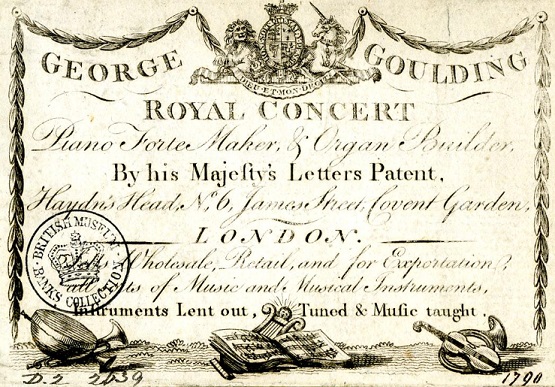
Figure 2. George Goulding's trade card, c.1790, courtesy of the British Museum.
At some point around the year 1799 Goulding took on partners and significantly increased his business. An advertisement in the Hampshire Telegraph newspaper for the 25th of November 1799 gave the name of the business as being Goulding, Phipps, and D'Almaine and it described them as Real Manufacturers of Military Musical Instruments, and Music-sellers to Their Royal Highnesses the Prince and Princess of Wales, No 45, Pall-Mall, London . Goulding's named business partners were William Window Phipps (1767-1837) and Thomas D'Almaine (c.1784-1866). The list of business partner's would soon grow; the Oracle newspaper for the 4th of January 1808 referred to the dissolution of an initial partnership that probably handled their Irish business; the partners at that time included Goulding, Phipps and D'Almaine, also Henry Knevett, Mortimer Hicks Lewis and Thomas Potter. Knevett and Lewis left but the firm continued. Phipps would eventually retire from the business in 1810, the London Gazette listed the partners at that date as being: George Goulding, William Window Phipps, Thomas D'Almaine, Thomas Potter and John Wood. By 1816 when a further Irish subsidiary of the business was dissolved the partners were listed in the London Gazette as being Isaac Willis, Sarah Goulding (for self and Co Executors of G. Goulding), T. D'Almaine, Thomas Potter, John Wood and J. Mazzinghi.
As we have already seen, George would die unexpectedly in 1814. His widow Sarah Dennis Goulding (c.1766-1843) continued the business in his absence along with Joseph Mazzinghi (1765-1844) and Thomas D'Almaine. Mazzinghi in turn would leave in 1825, the London Gazette reported the remaining parters from that date to be Sarah Goulding and Thomas D'Almaine. The Globe newspaper for the 2nd of October 1833 recorded the eventual dissolution of this remaining partnership, from which date Thomas D'Almaine operated the business as D'Almaine & Co.. The name Goulding was dropped from the business title thereafter.
Returning to the subject of George's untimely demise in August of 1814, the London Pacquet newspaper for the 31st of August 1814 reported that he died in Westmorland-street, Dublin, in his 51st year . They appear to have been mistaken about his age, either that or George was born in 1763 rather than 1759. The Westmorland-street address is likely to have been that of his business partner (and nephew) Isaac Willis (1784-1869) at No 7, Westmorland-street. The Irish branch of the business had opened around 1804 and separated from the London business in 1816, after which Isaac traded independently along with his brother John Willis (1782-1823). Isaac and John were the sons of Goulding's sister Mary Willis, John would go on in 1817 to be responsible for publishing the Quadrilles of John Duval in Dublin, most famously those of The Lancers Quadrilles. The Goulding legacy in Music publishing continued for many years after George's own passing.
Goulding & Co. Business Names and Addresses
The business entity founded by George Goulding traded under various different names over the years. In several cases more than one name was used concurrently. They would also trade from several different London (and Dublin) addresses over time, once again there could be more than one address used concurrently in any given year. Most of their musical publications were issued without an explicit publication date on the cover, the publication dates of these works can, in most cases, only be estimated. Knowing which business names and addresses were in use in any given year can help to narrow down the probable range of publication dates for such works. That in turn is important when attempting to understand the broader effects of the dance publications on the social dance industry. We will now attempt to determine that information.
One of the more reliable sources of information is the various newspapers that made reference to the business, typically by way of advertisements. These publications are themselves dated and can be seen as a reliable indication of how the business wanted to be known, and where they were located, at those dates. The table that follows is an attempt to narrow down the names and addresses, together with supporting information, for each date.
| Date | Notes |
|---|
| 1790 | The Northampton Mercury newspaper for the 5th of June 1790 makes reference to the business of George Goulding at No 6, James-Street, Covent-Garden. So too does the similarly dated trade card seen in Figure 2. Some sources add Haydn’s Head to this address. |
| 1792 - 1797 | The Northampton Mercury newspaper for the 19th of May 1792 continues to make reference to the business of G. Goulding at No 6, James-Street, Covent-Garden. The same information appears on the cover of their Twenty four Country Dances for the Year 1792. It remains true for the equivalent publications issued for both 1793 and 1797. |
| 1799 | The Hampshire Telegraph newspaper for the 25th of November 1799 advertised on behalf of Goulding, Phipps, and D'Almaine at No 45, Pall-Mall, London. They were evidently operating from a new address, it's unclear at which date they moved though was presumably between 1797 and 1799. Goulding's business partners were added to the business somewhere between 1792 and 1799. Goulding's Twenty four Country Dances for the Year 1799 continued to name the business as G. Goulding but sitched to using the Pall Mall address, the same was true of their collection for 1800 (see Figure 3). |
| 1800 | The Newcastle Courant newspaper for the 3rd of May 1800 advertised on behalf of Goulding, Phipps, and D'Almaine at No 45, Pall-Mall, London and also at 76, St James's-street, London. The Pall-Mall address was their Music Warehouse , the St James's Street address was their Manufactory . A similar advertisement with the same information can be found in the Kentish Weekly Post for the 30th of December 1800. |
| 1801 | Many advertisements across the year 1801 are consistent with the information from 1800. The Sun newspaper for the 15th of October 1801 is somewhat interesting for listing them at No 45, Pall-Mall, London under the name Goulding and Co.. A more formal advertisement issued in the same newspaper for the 18th of December 1801 reverted to the full title of Goulding, Phipps, and D'Almaine which appears to have been the entity's preferred name. |
| 1802 | The Star newspaper for the 18th of March 1802 once again referred to them as Goulding and Co., this time in a more formal advertisement. It appears that they were sometimes referring to themselves under this name. They continued to operate from the Pall-Mall and St James's street addresses. Some further references to the business use this shorter name throughout the year, though not exclusively. For example, the Morning Post for the 23rd of April 1802 used the name Goulding, Phipps and D'Almaine. Both names seem to be used concurrently. |
| 1803 | The business names and addresses from 1802 continue to be used throughout this year. The longer name is more frequently used but it is sometimes shortened to Goulding and Co.. The final reference I've found to them at the Pall-Mall address was published in the Gloucester Journal for the 28th of November 1803. |
| 1804 | The first reference I find to them in 1804 was published in The Courier newspaper for the 10th of March 1804, it names them as Goulding, Phipps, and D'Almaine but gives their address as No. 117, New Bond-street. A following advertisement in the Sun newspaper for the 9th of May 1804 explicitly reports that they are removed from No 45, Pall-Mall ; they may have also removed from the St James's street address at this same time, the advertisement adds Messrs G. and Co being real Manufacturers of Military Musical Instruments, Patent Clarinets, Flutes, &c. Regiments supplied with complete Sets, on the shortest notice, at their Manufactory as above. It's likely that they consolidated their two properties into one around the start of 1804. Later in 1804 we find references to an Irish subsidiary, eg in the Morning Post for the 5th of July 1804 which refers to Goulding, Knivett and Co. at Westmorland-street, Dublin. |
| 1805 | The Morning Chronicle newspaper carried an advertisement on the 11th of January 1805 that named the business as Goulding, Phipps, D'Almaine and Co and gave their address as both 117 New Bond-street, London and No 7, Westmorland-street, Dublin. These two addresses were promoted throughout the year. Goulding's Twenty four Country Dances for the Year 1805 gave the business name as Goulding & Co. and advertised both the New Bond Street and Dublin addresses. It also acknowledged J. Stevens of Glasgow as being associated with the business. |
| 1806 | Both the London and Dublin addresses continued to be used this year. For example, the Morning Herald newspaper for the 26th of December 1806 referred to them as Goulding and Co and gave both the New Bond-street and Westmoreland-street addresses. |
| 1807 | Most references to the business omit the Dublin address this year. An exception can be found in the Hibernian Journal for the 22nd of April 1807 which lists both the London and Dublin addresses and names the business as Messrs Goulding & Co.. The initial partnership involving the Irish subsiduary would be dissolved around the start of 1808, they may have downplayed their Irish connection during a period of uncertainty. |
| 1808 | An advertisement in the Morning Post newspaper for the 7th of January 1808 continues to list the business as Goulding, Phipps, and D'Almaine but gave their address as No 124, New Bond Street. It's unclear to me whether they moved a few doors down the road or whether the buildings on the road were all re-numbered. The Star newspaper for the 4th of March 1808 carried an advertisement that named then as Goulding, Phipps, D'Almaine, and Co. and gave their address as both 124, New Bond Street and 7, Westmoreland-street, Dublin. It is likely that the Irish subsidiary had been re-established under Isaac Willis at around this date following the departure of Knevett and Lewis. They continued to be known by this longer name, and at both addresses, throughout the year. |
| 1809 | The longer form of the business name continued to be used, as did both the London and Dublin addresses. Goulding's Twenty Four Country Dances for the Year 1810 (which was probably published towards the end of 1809) named the company as Goulding, Phipps, D'Almaine & Co and offered both the 124 Bond Street and 7 Westmoreland Street addresses; the association with J. Stevens of Glasgow was no longer being promoted (whereas Stevens had remained referenced on the cover of the intervening titles).
|
| 1810 | An advertisement in the Star newspaper for the 24th of August 1810 gives both a new company name and a new address; they're named as Goulding, D'Almaine, Potter and Co. and their addresses now include 20 Soho-square (see Figure 1) in addition to the 124 New Bond-street and 7 Westmoreland-street, Dublin addresses. This is around the time that Phipps left the business; Potter may have been brought in as his replacement. The new Soho address would be their primary address going forwards. Goulding's Twenty Four Country Dances for the Year 1811 (which was probably published towards the end of 1810) gave the company name as Goulding, D'Almaine, Potter & Co., it did not reference the new Soho address. |
| 1811 | An advertisement in the Morning Chronicle newspaper for the 25th of January 1811 shortened the business name back to Goulding and Co. and gave their addresses as 20 Soho-square and 7 Westmoreland-street, Dublin. The 124 New Bond Street address seems to have gone by this date, it was in possession of Chappell and Co by the end of January (Morning Herald, 25th of January 1811). |
| 1812 - 1815 | The business continued to be referred to as Goulding, D'Almaine, Potter and Co. and to operate from both the Soho and Dublin addresses. Goulding's name remained associated with the business even after he died, his widow Sarah took over his role. |
| 1816 | The business continued to be referred to as Goulding, D'Almaine, Potter and Co. and to operate from the Soho address, the Dublin address would no longer be referenced in advertisements after Isaac Willis left. For example, their advertisement in the Morning Post newspaper on the 28th of February 1816 omits any reference to the Dublin address. It would continue to appear on the cover of their annual Country Dance publications however, perhaps implying an unwillingness to rework the printing plates, or perhaps indicating an ongoing connection to the now independent Willis business. |
| 1817 | The business continued to be referred to as Goulding, D'Almaine, Potter and Co. and to operate from the Soho address. |
| 1818 | The business is referred to either as Goulding, D'Almaine, and Co. or more simply Goulding & Co.. It continues to operate from the Soho address. The implication seems to be that Potter may have become less involved with the concern from around the start of 1818. |
| 1819 | The business is referred to as Goulding & Co.. It continues to operate from the Soho address. An advertisement in the Morning Post newspaper for the 6th of July 1819 also announced the existence of a Soho Harmonic Institution operating from the Goulding address, this seems to have been a showroom for modern musical instruments. |
| 1820 - 1833 | The business is usally referred to in advertisements as either Goulding & Co. or Goulding, D'Almaine, and Co. Occasional references are found to Goulding, D'Almaine, Potter, and Co, Potter may have remained with the business. Their collection of 24 Country Dances for 1826 removed Potter's name from that of the business, he may have completely left the partnership at around that date. |
| 1834+ | Sarah Goulding left the business and it was renamed to D'Almaine & Co. |
The information in the above table should assist to date those Goulding branded publications for which no clear date is evident.
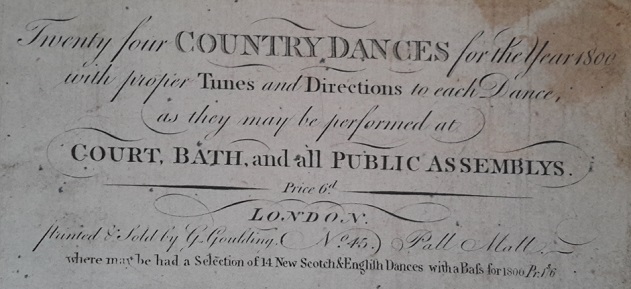
Figure 3. G. Goulding's Twenty four Country Dances for the Year 1800.
The Country Dance Publishing Industry of the Early 19th Century
We've written about Country Dance publishing many times before, we've investigated several of the major Country Dance publishers of the late 18th and early 19th centuries in previous papers. Across much of the 18th Century Britain's Country Dance purchasing public were served by a handful of (mostly) London based music shops; from perhaps the late 1780s that situation began to change, more and more independent music producers began operating in London. Where a handful of music shops had once produced a single annual collection of dances each, ever more would begin doing so. Many didn't limit themselves to a single annual collection, some started issuing collections on a much more frequent basis, perhaps even monthly.
The catalyst for this increase in music publishing isn't entirely obvious. It may have been technological, perhaps the means of publishing had become more affordable - paper and ink production, engraving, printing, distribution networks and so forth may have combined to make publishing an easier option for music sellers. It may have been economic - Britain of the early 19th century was an increasingly wealthy nation, the profits of empire fuelled a nation of professional tradesmen with a greater disposable income, perhaps there was more disposable wealth with which to purchase music. It may have been musical - ever more middle class families in Britain had access to a musical instrument and had a desire for printed music with which to practice. Maybe many reasons combined. Whatever the causes, the number of music shops in London issuing collections of Country Dances proliferated. We've written of several such publishers before, examples included William Campbell, Button & Co., Skillern & Challoner, the Cahusacs, Charles Wheatstone and James and Martin Platts; every one of these publishers flourished in the early 19th century. Goulding & Co. were one more such publisher. Goulding & Co. had issued annual collections of Country Dances from the late 1780s in the style that London had become used to for much of the 18th century (see for example Figure 3), when the market for higher quality and more frequent collections emerged (around the start of the 19th century) they produced music for that market too. In some respects the Goulding collections are quite interesting, there is some evidence to suggest that other publishers followed them, republishing the same tunes that they had published shortly thereafter. They were certainly one of the major producers of printed music in London, especially for wholesale distribution elsewhere around the nation, their dances are likely to have sold well.
But with so many music publishers active, it was perhaps inevitable that the Country Dance market would saturate. The multitude of Country Dances publishers vying with one another for the attention of the same purchasers caused problems to emerge. Supply might outstrip demand, prices would stay artificially low and legal disputes encouraged internecine strife within the industry. The rise of new and disruptive dance trends would further unsettle the market, dances such as the Waltz and Quadrille would increasingly distract the music purchasing public. Eventually, towards the end of the 1810s, the industry itself would collapse. Where there had been several dozen music publishers at the start of the 19th century, there would be barely any issuing Country Dance collections into the 1820s and beyond... though Goulding & Co. were one of the few survivors. Perhaps they survived due to the quality of their dance music, perhaps the size of their resale market, or perhaps just the depth of their pockets combined with a willingness to continue publishing long after their competition had given up. Whatever the reason, Goulding & Co. outlasted almost everyone else in the industry, they continued issuing annual Country Dance collections through to the end of the 1820s, with at least some collections issued into the 1830s and 1840s.
Annual Goulding & Co. Country Dance Collections
There are two major collections of Country Dance publications that were issued by the variously named Goulding & Co businesses. They can be loosely categorised as the annual collections and the irregular collections . The annual collections were issued on an approximately annual cadence of one per year, the irregular collections on a less predictable schedule. The annual collections were issued for the Year XXXX , this offers a strong clue for dating those collections. They were either issued in the year implied by the title, or perhaps towards the end of the preceding year (with the intention of influencing the market for the following year). The table below contains information on the various annual collections, we'll return to consider the irregular collections shortly.
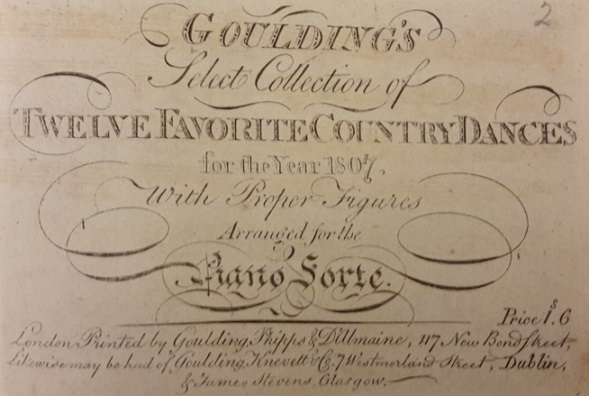
Figure 4. Goulding's Select Collection of Twelve Country Dances for the Year 1807
The annual collections are made up of elements from three different series. The major series was titled Twenty Four Country Dances for the Year XXXX (see for example Figure 3), it ran between approximately 1788 and 1827 (there may have been earlier or later examples, these are just the date ranges between which we can be sure collections were issued). There exists a title from this collection for almost each year; it's probable that there has existed a title for the handful of missing years too, if so then I've yet to encounter surviving examples of them. There are further collections of this name published in the 1830s and 1840s by D'Almaine & Co., the successor to Goulding & Co.; we've not included those publications within this table. A second series was published between approximately 1806 and 1809 titled Twelve Country Dances for the Year XXXX (see for example Figure 4). This second series was printed with a higher quality of music: where the 24 collections included only a simple treble score, the 12 collections had both a treble and bass score. A third series titled Collection of New & Favorite Country Dances, Reels & Waltzes arranged by John Parry (1776-1851) also existed. This third series continued the concept of higher quality music, it featured either two or three lines of music in each score. All three series included suggested dancing figures for each dance (unlike the irregular series that we will come back to later).
Before we consider the individual collections there are a few observations from across the range that can be made. The first thing to notice is the price of the collections. The earlier examples were initially sold at just six pence, yet somewhere around 1805 the price increased to one shilling, a price that remained in effect for the rest of the range. The higher quality Twelve Country Dance collections cost more, they were one shilling and six pence and presumably were aimed at a more discerning customer than the Twenty Four Country Dance collections. The third collection was priced even higher still, it sold for two shillings and six pence. This third series might perhaps have been intended for professional musicians.
Another observation is that the cover design of the Twenty Four collections did change over time, typically when the company name and/or address changed. A reasonably consistent cover design was used for the collections up to that for the year 1804 (which was probably created in late 1803), these collections gave the business name as G. Goulding and their address as being either James Street or Pall Mall. The business moved to their 117 New Bond-street address in early 1804, the collections issued for 1805 to 1809 (which was probably produced towards the end of 1808) employed a new cover that advertised this new address and referred to the business as Goulding & Co.. The address of the business changed again in 1808, this time to 124 New Bond-street, the cover design also changed to match, the new design was used between 1810 and 1814 and gave the business name as Goulding, Phipps, D'Almaine & Co. A small correction to the address of the business was introduced for the 1813 collection (which was probably created towards the end of 1812) when their new Soho Square address was advertised. They had been using the Soho address since 1810 so were evidently slow to redesign the cover. George Goulding died towards the end of 1814, this might have been the trigger for another redesign; the collections issued for 1815 to 1822 used another design, this time the company name was given as Goulding, D'Almaine, Potter & Co. Another new change was made for the 1823 collection, the business name and address remained unchanged but a reference to Almack's was added to the cover. A final change was introduced for the 1826 collection where Potter's name was removed from the company title, it was thereafter referred to as Goulding & D'Almaine.
One further curiosity is that some of the collections include occasional composition credits. The vast bulk of the tunes do not include such references, they begin to emerge from the collection for 1809. Several of the tunes are credited to John Parry (1776-1851), a handful of other composers are also named. Some of the dances in the collections from 1811 are marked (P) ; the collection for 1821 notes that this symbol implies that a tune is subject to Copyright. If that symbol had been used consistently across the titles then it may be a clue that the Goulding business was increasingly aware of the need to track copyright for tunes as the 1810s progressed. Copyright for dance music is a subject that we have investigated previously. Goulding & Co had lost an important copyright dispute in 1809 after being challenged by their rivals at Clementi & Co, their loss may have triggered a decision to be a little more cautious around matters of copyright and attribution in their publications going forwards. That 1809 loss resolved an important legal question however: did the copyright laws that applied to books also apply to single sheet musical publications? It transpires, to Goulding & Co's cost, that they did. That particular dispute involved a song named Heigh Ho! that they had published without permission.
Returning to the dance publications, the tunes and dances found within these annual collections tend to be unimpressive. The vast bulk of the tunes were not especially popular at the time of publication (as measured by referenced in other sources and republication by other music shops), most have relatively little merit to recommend them today. There are exceptions, a few of the tunes were legitimately popular. Whereas, when we come to consider the irregular publications shortly, we'll find that they contain many genuinely popular tunes. The cheap annual collections did not contain the best material that Goulding & Co had available to them.
One final observation relates to the names of the tunes in the collection issued for 1788. The titles are evidently jokes but they may require a little explanation. A convention existed in the elite Assembly Rooms whereby, when a longways set formed to dance a Country Dance, the Master of the Ceremonies would ask the leading couple two questions: What Tune? and What Figure? . The leading lady had the priviledge to select the tune that would be danced, and the figures that would be danced to that tune. The names in the 1788 collection are intended to offer hilarity when used in response to the What Tune? query. The amusing responses, if selected from Goulding's collection, would include I can't tell you , Why do you ask me and Ask the bottom couple . I imagine this joke did not resonate with the public as it wasn't repeated. Nonetheless, it's curious to see the convention referenced in a budget Country Dance collection. The odd nature of this collection causes me to suspect that it was the first such collection that Goulding & Co. produced.
What follows is a table of the known (to me) Goulding & Co. dance collections that were issued for a particular year.
| Work & Date | Image | Comments |
|---|
Twenty Four Country Dances for the Year 1788 |

|
The contents are: Cross purposes, I can't tell you, A very good one, What's that to you, A whim of my own, I'll think of it presently, It's lost its name, I've forgot it, My partners frolick, Call it your own, Something I suppose, Ask your partner, I'll tell you by and by, Anything or nothing, Why do you ask me, An odd number, What do you think, I don't know, Lets be merry, What you please, This has no name, I don't recollect, Ask the bottom couple, I'm the last person you should ask.
Full Title: Twenty four Country Dances for the Year 1788 with proper Tunes and Directions to each Dance, as they may be performed at Court, Bath, and all Public Assemblys. Price 6d.
|
Twenty Four Country Dances for the Year 1789 |

|
The contents are: Chapman's Dance, The House of Rew, Lady Townshend's Delight, Indian Nabob, Les Notables, The Devil to do, Duke of York's Whim, New Plow Boy, Mrs Dalrymple's Reel, ?, ?, The Bustle, The Sailors Joy, Mrs Hamilton of Bargenny's Reel, An odd fancy, Fox's whim, Prince of Wales Fancy, Westminster Election, Corri's fancy, The Highway to Coilsfield, This will do, ?, The Countess of Percy's Reel, The Pippingo Reel.
Full Title: Twenty four Country Dances for the Year 1789 with proper Tunes and Directions to each Dance, as they may be performed at Court, Bath, and all Public Assemblys. Price 6d.
|
Twenty Four Country Dances for the Year 1792 |

|
The contents are: Surrender of Calais, Casentini, La Locando, Telemaque, Didelots Fancy, The Rights of Man, La Bella Pescatrice, La Molinarella, Battle of Prague, Idalide, La Fille mal Gardee, Seige de Cittere, The Hindostan, Wit & Mirth, Printers Devil, The Deserted Hamlet, Rousseau's Tomb, Pleyel's Concertante, Theodores Fancy, Flashey Bett, Jacke a Lent, Corporal Casey, Armida, The Royal Flight.
Full Title: Twenty four Country Dances for the Year 1792 with proper Tunes and Directions to each Dance, as they may be performed at Court, Bath, and all Public Assemblys. Price 6d.
|
Twenty Four Country Dances for the Year 1793 |

|
The contents are: The Majician, Miss Christie Dalrymple's Fancy, The Temple, The Surrender of Calais, Miss King's Fancy, Miss Holdsworth's Delight, Vale of Evesham, Soutra Hill, Day in Turkey, Miss Phipps's Fancy, Bagshot Camp, Tipony Know, Mrs Astleys Fancy, The Land of Cakes, Moorend Farm, Stinchcomb Hill, Miss Clarke's Fancy, Woodcot Park, Mrs Falconar's Fancy, Johnstonburn, Royal Archers, Bonny Geordies Wig, Yester House, The Laird of Appin.
Full Title: Twenty four Country Dances for the Year 1793 with proper Tunes and Directions to each Dance, as they may be performed at Court, Bath, and all Public Assemblys. Price 6d.
|
Twenty Four Country Dances for the Year 1797 |

|
The contents are: The New German Waltz, Snenton Coffee House, Drury Hill, A trip to York, The Iron Chest, The Lock & Key, Mazzinghis Fancy, The Way to get Married, The Charity Boy, The Rock of Silley, The Merry Fidler, The Tabor Boy, Miss G Diroms Fancy, Woods Hornpipe, Miss Coopers Allemande, Your Fancy, Lawreys Fancy, Trip to Matlock, Miss Douglasses Fancy, The Bouquet, The Bonny Lad, Miss M Diroms Fancy, Grunting Weston, The Starling.
Full Title: Twenty four Country Dances for the Year 1797 with proper Tunes and Directions to each Dance, as they may be performed at Court, Bath, and all Public Assemblys. Price 6d.
|
Twenty Four Country Dances for the Year 1798 |
|
The contents (courtesy of WorldCat) are: The Devil & the Lawyer, Two turnips to a Leg of Mutton, The Parish Clerk, Call Mother red Cap, The Whirlwind, The Desperadoes, Turn about Johny, Jumping Jane, Little Jenny's Waltz, Pall Mall, What's the Fashion, The Grotto, Go to the Devil and Shake yourself, What's that
Right and Wrong, Father Paul, The Ragamuffin, Jalop-hall, Mary Anns fancy, Cat without tail, The horse and his rider, German waltz, Roses Fancy, The Paper Bonnet.
|
Twenty Four Country Dances for the Year 1799 |

|
The contents are: Eliza Augusta, Poole Volunteer Artillery, The drunken Gager, The Straw Bonnet, Castlebar, The new Waltz, Major Jeffery's Waltz, Mr Hamilton of Washars Reel, The Hanoverian Waltz, The Dutchess of Gordens Reel, A Trip to the Camp, The Humours of Kilkenny, Bedford Races, The new Devonshire Reel, Captn O Kains Fancy, Lady Aucklands Strathspey, McNabs Reel, The Duke of Yorks Quick Step, Lady Cliffords Fancy, Col McDuffs Quick Step, Windsor Camp, The Braes of Auchtertyre, The Garden in the Canongate, De'els Dead.
Full Title: Twenty four Country Dances for the Year 1799 with proper Tunes and Directions to each Dance, as they may be performed at Court, Bath, and all Public Assemblys. Price 6d. |
Twenty Four Country Dances for the Year 1800 |

|
The contents are: Magic Oak, The Castle of Sorrento, La Fille Malgarde, Abercrombie's Quick Step, The Secret Expedition, Miss Maria Reed's Reel, The Merry Girls of Windsor, Ramchoondra, Miss Malletts Reel, Ramah Droog, Margery Grinder, Capture of Seringapatam, Madam Laborie's Favourite, The Red Cross Knights, The Corn Threshers, Steibelts Fancy, Mrs Meyricks Reel, The Duke of Cumberland's Waltz, Miss, or Master Sitwell's Strathspey, All is well that Ends well, Jean De Acre, The Broad Sword Hornpipe, Helder Point, A Trip to Holland.
Full Title: Twenty four Country Dances for the Year 1800 with proper Tunes and Directions to each Dance, as they may be performed at Court, Bath, and all Public Assemblys. Price 6d. |
Twenty Four Country Dances for the Year 1801 |

|
The contents are: Devil among the Taylors, Swinley Camp, The Female Volunteers, Woods Fancy, Trip to Ratcliff, Lady Lucy Rumseys Favorite, Lord Eglintons Reel, Trip to Hinkston, Potters Reel, Roshars Hornpipe, The Turnpike Gate, The Rivals, What a Blunder, Country Bumkin, The Charms of the Fair, Woburn Abbey, Sherburn Castle, Trip to Margate, Michells Fancy, St Davids Day, The Easter Hunt, The Little Hay Maker, Merry Meeting, Random Shot.
Full Title: Twenty four Country Dances for the Year 1801 with proper Tunes and Directions to each Dance, as they may be performed at Court, Bath, and all Public Assemblys. Price 6d. |
Twenty Four Country Dances for the Year 1803 |
|
Copies of this work are known to exist but I have yet to study it. |
Twenty Four Country Dances for the Year 1804 |
|
The contents (courtesy of WorldCat) are: The chantreuse, The dark tower, Lady Hamiltons new waltz, Lord Courtney's hornpipe, Lady Mary Douglas, Lady Harriet Hope's reel, The rout is come, Lady Cholmondley's waltz, Mary's dream, The bird catcher, Mr. Macintyre's reel, Mighty Mars, The wreath, Miss M H Newlyn's reel, Tom Moody, Denis Brulgruddery, The Royal Standard, The Fawley light dragoons, Road to Mirth, Barbara Dumper, Angerstein or the Patriot Briton, The mad attemp't, E O or what dy'e call it, Mammoth & Buonaparte.
|
Twenty Four Country Dances for the Year 1805 |
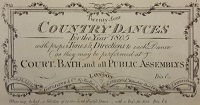
|
The contents are: The Royal Visit, Captain Dance's Ball's, Albany House, Madam Figgs Gala, Laura and Lenza, The Gay Decievers, Havering Bower, The Awkward Recruit, The Thornton Jigg or York Race, The Lady's Bosom Friend, Miss Rowley's Fancy, Scalding of Peas, The Girl of my Heart, Young Roscius or the Prodigy, The Wild Girl, Carlo's Waltz, Love & Glory, Billy Larkin's Waltz, The Silver Star, Lady Caroline Lee's Waltz, The Wife of two Husbands, The Corsican Ruffian, Music Love & Beauty, Foley Reel.
Full Title: Twenty four Country Dances For the Year 1805 with proper Tunes & Directions to each Dance (as they may be performed at) Court, Bath, and all Public Assemblys. Price 1s. |
Twelve Country Dances for the Year 1806 |

|
The contents are: The Hurdy Gurdy, The Guinea, Lady C. Campbell's Waltz, Hanoverian Waltz, The Honey Moon, The Caledonian Rondo, or Lady, Montgomery, The Weymouth Fete, The Marriage Contrast (danced by Miss Adams in Dublin), Lady Larker's Reel, The Soldier's Return, Ride a Mile, Caro Dolce.
This particular work was advertised for sale by Goulding's Irish subsidiary in the Saunders's News-Letter newspaper for the 11th of January 1806, it was being sold for 1s7d in Dublin (a penny more than the price in London).
Full Title: Goulding's Select Collection of Twelve Favorite Country Dances for the Year 1806 with proper Figures Arranged for the Piano Forte. Price 1s6. |
Twenty Four Country Dances for the Year 1806 |
|
Copies of this work are known to exist but I have yet to study it. |
Twelve Country Dances for the Year 1807 |
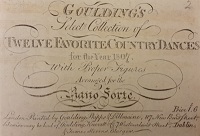
|
The contents are: Paddy O'Snap, Miss Montgomery's Fancy, The Duke of York's Birth Day, European Waltz, Jack Laten, Her Royal Highness the Princess Charlotte's Fancy, Cape Trafalgar, A Trip to Buenos Ayres, African Waltz, Von Esch's Favorite, Talleyrand's Waltz, Lord Percy's Favorite.
Full Title: Goulding's Select Collection of Twelve Favorite Country Dances for the Year 1807 with proper Figures Arranged for the Piano Forte. Price 1s6. |
Twelve Country Dances for the Year 1808 |
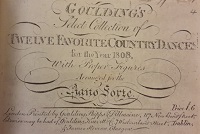
|
The contents are: The Wolds of Sussex, The Lake of Lindermere, Lady Mac Kenzie's Favorite, Mr I Walkers Fancy, Admiral Gambier's Reel, Miss Billingcrofts Waltz, Lady Charlotte Campbells, Miss Goldsmith's Allemande, Lord Cathcart's Whim, Lady Catharine Pelhams Reel, Miss Mac Donalds Fancy, The Westminster Volunteers or the new Quick March.
Full Title: Goulding's Select Collection of Twelve Favorite Country Dances for the Year 1808 with proper Figures Arranged for the Piano Forte. Price 1s6. |
Twenty Four Country Dances for the Year 1808 |
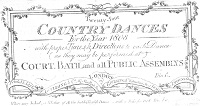
|
The contents are: The Dutch Skipper, Ap Shenkin, Spring Grove, Miss Adams's Waltz, Rosin the Bow, The Brighton Puzzle, Voyage to India, Lady Mildmay's Waltz, Cupid's attack on Old Maids, Captn Brisbane's Frolic, Admiral Gambier's Waltz, Adam's Hornpipe, All the Go, The Dutchess of Brunswicks Waltz, Flights of Fancy, Grimaldi's Whim, Music Mad, Bannister's Budget, Monfrina, Tekeli, A Trip to the Baltic, Gas Lights, Lord Cathcart's Reel, Surrender of Copenhagen.
Full Title: Twenty four Country Dances For the Year 1808 with proper Tunes & Directions to each Dance (as they may be performed at) Court, Bath, and all Public Assemblys. Price 1s. |
Twelve Country Dances for the Year 1809 |
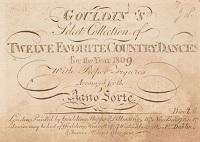
|
The contents are: The Honble. Miss Anson's Jig, Miss Poole's Fancy, Lady Sophia Keppel's Dance, Quarrel - and make it up again, The Spanish Patriots, Miss Webster's Strathspey, The Princess of Wales Waltz, A Negro Dance, Miss Williams Fancy, Lady Dungannon's Waltz, The Widow, or Prime of Life, Love Port and Sherry (taken from a song Compd by Mr Parry), The Thoughtless (A Waltz), The Plumstead Reel, Constance & Almazor, Sandy's Reel, The Cheltenham Spa, Nothing New, A Pandean Waltz, The Fairy Prince, Madame Catalani's Waltz, Time's a Tell Tale.
Full Title: Goulding's Select Collection of Twelve Favorite Country Dances for the Year 1809 with proper Figures Arranged for the Piano Forte. Price 1s6.
|
Twenty Four Country Dances for the Year 1809 |
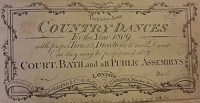
|
The contents are: The Runaway, King of the Catties, The Fairy Dance, The Thoughtless, The Widow, or Prime of Life, Capper Fey, The Nameless, Brompton Reel, Time's a Tell Tale, Miss Spicer, The Sylphs, Caro Dolce, The Redicule, Foley Reel, Miss Williams Fancy, Princess Dolgorucky, Ella Rosenburg, Drops of Comfort, Miss Limerick (from Parry's Lyrist), The Spanish Patriots, The Labyrinth, Sandy's Reel, The Cambrian Lyrist, Constance and Almazar.
Full Title: Twenty four Country Dances For the Year 1809 with proper Tunes & Directions to each Dance (as they may be performed at) Court, Bath, and all Public Assemblys. Price 1s. |
Twenty Four Country Dances for the Year 1810 |
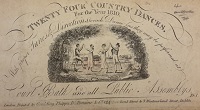
|
The contents are: Flora Macdonald, The Exile, The Queen of Sluts, Basque Roads, The Leathern Bottle, Lord Cathcart, Talavera, Momfrina, Old Tom, The Montreal, The Russian Dance, The Pope's Waltz, The Self, Up All Night, King Arthur, The Love Sick Tar, Dollalolla (Parry), Morgiano, The Admiral, Timothy Quaint, The New Spanish Patriots, Michael Wiggins, The Island of Walcheren (Parry), The Water Lily (Parry).
Full Title: Twenty four Country Dances For the Year 1810 with proper Tunes & Directions to each Dance (as they may be performed at) Court, Bath, and all Public Assemblys. Price 1s. |
Twenty Four Country Dances for the Year 1811 |
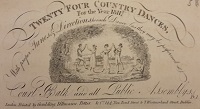
|
The contents are: Bang Up (By permission from Parry's Lyrist No 3), O.P., The Persian Ricardo, Mathew Briggs, Morgiana In Ireland, Crop the Croppies, Capt Kinlock's Reel (From Parry's Lyrist No 1), The Marquis of Harlington, Michael Wiggins in Ireland, Don Quixote, N.P. (P), The Thalia, Prime (P), Montreal, Hit or Miss (P), The Italian Momfrina, Persian Farewell, Jerry Blossom (P), Lord Cathcarts Favorite (Haydn). Lady Cathcart (P), The Princess of Wales Birth Day, Windsor Park, The Opera Hat (Published as a Rondo by Parry), The Black Swan.
Full Title: Twenty four Country Dances For the Year 1811 with proper Tunes & Directions to each Dance (as they may be performed at) Court, Bath, and all Public Assemblys. Price 1s. |
Twenty Four Country Dances for the Year 1812 |
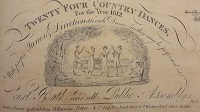
|
The contents are: Juliana, Drops of Whiskey (From Parry's Lyrist No 5), I'll Gang Na Mair to Yon Town, Peter Fidget, H.R.H. The Princess Charlotte's Favorite, Morgiana in Spain, Sadler's Balloon, One O' Clock, The Russian Waltz, The Flight, Quadrupeds, The Rage, The Weathercock, Moski (A favorite Russian Dance from Parry's Lyrist) (P), Lord Wellington, Town Talk, Fly not Yet, The Silken Snood, Miss Dillons Waltz (From Parry's Lyrist No 5), Sophia, The Prince Regent (From Parry's Lyrist), The King of Rome!!!, Bank Tokens, The Woodbine.
Full Title: Twenty four Country Dances For the Year 1812 with proper Tunes & Directions to each Dance (as they may be performed at) Court, Bath, and all Public Assemblys. Price 1s. |
New & Favorite Country Dances, Reels & Waltzes, No 1, 1812 |
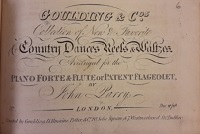
|
This collection was arranged by John Parry. It's likely that this was the first title in the series, unfortunately the number wasn't inked onto the cover of the copy that I've studied. The table of contents in the edition published for 1815 indicates that this work was published in 1812.
The contents are: The Prince Regent, Juliana, The King of Rome, I'll Gang Na Mair To Yon Town, Drops of Whisky, Quadrupeds, Lord Wellington, Moski, Miss Dilon's Waltz, One O Clock, The Opera Hat, Morgiana in Spain, The Russian Waltz, The Silken Snood, Peter Fidget, The Princess Charlotte of Wales Favorite, General Graham's Waltz, Sophia, The Patent Slipper, Timour the Tartar.
Full Title: Goulding & Cos Collection of New & Favorite Country Dances, Reels & Waltzes, No 1, 1812. Price 2s6d. |
Twenty Four Country Dances for the Year 1813 |
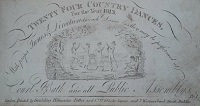
|
The contents are: The Recovery, The Prince Regent's Fete, Lord Wellington's Victory, Miss Hunter's Fancy, The Discovery, Miss Johnson's Waltz, The Russianade, The Duke of York's Waltz, Lady Barbara Cooper, The Heros of Salamanca, The Muses, The Eliza, The Pandean's Dance, The Petersburgh Waltz, The Comet Hornpipe, Salamanca, Marshall Marmont's Retreat, Miss Duncan's Allemande, Johnie Armstrong's Favorite, The Dutchess of Richmond's Strathspey, Corunna, Miss Davidson's Fancy, The Village Wedding, Phoebelia.
Full Title: Twenty four Country Dances For the Year 1813 with proper Tunes & Directions to each Dance (as they may be performed at) Court, Bath, and all Public Assemblys. Price 1s. |
New & Favorite Country Dances, Reels & Waltzes, No 2, 1813 |
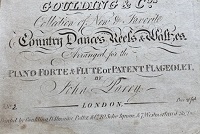
|
This collection was arranged by John Parry. The table of contents in the edition published for 1815 indicates that this work was published in 1813.
The contents are: The Recovery, Miss Johnson's Waltz, The Muses, Miss Hunter's Fancy, The Hero of Salamanca, Lady Barbara Cooper, Spanish Patriots a thousand years ago, Miss Duncans Allemande, Miss Davidson's Fancy, Johnie Armstrong, Smolensko, Munster House, The Essex Waltz, Salamanca, The Dediculous Redicule, The Spanish Waltz, General Pictons Waltz, The Devil's Bridge, The Eliza, The Regent's Park.
Full Title: Goulding & Cos Collection of New & Favorite Country Dances, Reels & Waltzes, No 2, 1813. Price 2s6d. |
Twenty Four Country Dances for the Year 1814 |
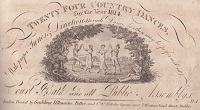
|
The contents are: Prince Kutusoff, The Pyrenees (J.B.), The Shannon (J.B.), The Cottage Bonnet, The Vauxhall Trip (J.B.), Mrs McLeod of Rosa, Copenhagen Waltz, Regents Park, Vittoria, Long Live The Prince Regent, The Pelican, The Cottage Waltz, Windsor Park, Enrico, Saragossa, Fairlop Fair, Roberts Fancy, The Toy, The Moscow Waltz, Sharp & Flat, Harry Le Roy, Miss Platoffs Waltz, The Brazen Bust, Vauxhall Waltz.
Full Title: Twenty four Country Dances For the Year 1814 with proper Tunes & Directions to each Dance (as they may be performed at) Court, Bath, and all Public Assemblys. Price 1s. |
New & Favorite Country Dances, Reels & Waltzes, No 3, 1814 |
|
This collection was arranged by John Parry. The table of contents in the edition published for 1815 indicates that this work was published in 1814.
The contents are: Mrs McLeod, The Crown Prince, Voulez vois danser Mademoselli, Berlin Waltz, The Shannon, Harry le Roy, Brave Moreau, Enrico, Teneriff, Vittoria, Sharp & Flat, The Regents Fete, The Dresden Waltz, The Cottage Waltz, The Austrian Waltz, The Tank, The Copenhagen Waltz, Battlesden Park, St Sebastian, Tommy Jenkins.
|
Twenty Four Country Dances for the Year 1815 |
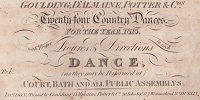
|
The contents are: The Princess Charlotte, Lady Caroline Bertie, Orange Boven, Orange Boven Waltz, The Cossack, Calder Fair, Hyde Park Fair, The Duchess of Angouleme, The Farmers Wife, Wellington in France, The Chinese Bridge, The Brunswick Waltz, For England Ho, The Isle of Elba, Nap in the Clouds, Louisa, The Lily Waltz, The Jugglers, The Jubilee, Field Marshall Blucher, The Swiss Waltz, Morgiana in the Park, The Brave Moreau, The Jubilee Waltz.
Full Title: Goulding, D'Almaine, Potter & Cos Twenty-four Country Dances For the Year 1815, with Proper Figures & Directions to each Dance (as they may be performed at) Court, Bath, and all Public Assemblys. Price 1s. |
New & Favorite Country Dances, Reels & Waltzes, 1815 |
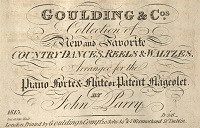
|
This collection was arranged by John Parry and is dated to 1815.
The contents are: Calder Fair, The Princess Charlotte, Mrs. George Dering's Waltz (Parry), Alexander's Favorite, The Pagoda, The Byrne Waltz, Field Marshal Blucher, The Swiss Waltz, Count Platoff, Peter Patch (Parry), The Bourbon Waltz, The Glasgow Reel, Miss Gossling's Favorite, The Oldenburgh Waltz (Parry), The Temple of Concord, Wellington the Brave, A Trip to Paris, Burlington House, The Norway Waltz, Congreve Rockets.
Full Title: Goulding & Cos Collection of New and Favorite Country Dances, Reels & Waltzes, 1815. Price 2s6d. |
Twenty Four Country Dances for the Year 1816 |

|
The contents are: The Coburg Waltz (Parry), The Royal Union, The Cottagers (P), St Helena, Spots in the Sun (CR), The Gloucester Waltz (CR), Wellington's Welcome Home, The Flying Sorcerer, Dennis O'Phin (CR), Exit By Mistake, Un Tour A Paris (CR), The Cadiz Mortar, Madam Sachi (CR), The Siege of Algiers, The Rainy Season, he Rose & The Lily, The Regent's, Waltz (Parry), The Conspiracy, Master Wiggins (CR), Salamaca , ak, The Bazar (CR), My Landlady's Gown (CR), Phillip's Dog, A General Peace.
Full Title: Goulding, D'Almaine, Potter & Cos Twenty-four Country Dances For the Year 1816, with Proper Figures & Directions to each Dance (as they may be performed at) Court, Bath, and all Public Assemblys. Price 1s. |
New & Favorite Country Dances, Reels & Waltzes, 1816 |
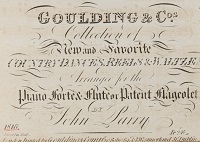
|
This collection was arranged by John Parry and is dated to 1816.
The contents are: The Swiss Dance, The Cumberland Waltz, The Forest of Bondy, Waterloo, The Bugle Waltz, The Tyrolese Waltz, The Prisoner, The White Flag, The Gypsey Waltz, Miss Bourke's Waltz, The Noble Outlaw, John of Paris, The Duke of Wellington's New Waltz, La Josephine, De Chasse, The Surprise, The New Scilian Dance, The Allies at Paris, The Lass of Dundee, The Marquis of Anglesea's Waltz.
Full Title: Goulding & Cos Collection of New and Favorite Country Dances, Reels & Waltzes, 1816. Price 2s6d. |
Twenty Four Country Dances for the Year 1817 |
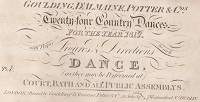
|
The contents are: The Forest of Bondy, Corporal Violet, The Lass of Dundee, Doctor Sangrado, My Aunt at the Lyceum, The Bugle Waltz, The Swiss Dance, The Regents Waltz, The Gypsy Waltz, The Prisoner, The Sociable, The Noble Outlaw, The Miller & His Men, La Josephine, The Battle of Waterloo, Lord Wellington's Waltz, The Wandering Boys, Whimsiculo, Prince Blucher's Waltz, The Congress, Broad Grins, John of Paris, King of Prussias Waltz, Wellington & Victory.
Full Title: Goulding, D'Almaine, Potter & Cos Twenty-four Country Dances For the Year 1817, with Proper Figures & Directions to each Dance (as they may be performed at) Court, Bath, and all Public Assemblys. Price 1s. |
New & Favorite Country Dances, Reels & Waltzes, 1817 |
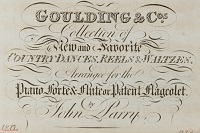
|
This collection was arranged by John Parry and is dated to 1817.
The contents are: The Coburg Waltz, The Cottagers, Rosy Cheeks (Kiallmark), The Cadiz Mortar, St Helena, Wellington's Welcome Home, A General Peace, Phillip & His Dog, The Regent's Waltz (Parry), Rosalie, Delia, The Queen Charlotte, Un Tour A Paris, Miss Kelly's Waltz, The Shepherd Boy, The Rose & The Lily, The Prussian Dance (Parry), The Naples Waltz, The Delicate Flower, The Canary-Bird Waltz (Parry).
Full Title: Goulding & Cos Collection of New and Favorite Country Dances, Reels & Waltzes, 1817. Price 2s6d. |
Twenty Four Country Dances for the Year 1818 |

|
The contents are: La Gascon Volage (The flying Boy), The Tom Tit, The Young Hussar, The Black Dwarf, Don Giovanni, Fire & Water, The Tyrolese Dance, The Fatal Island, Les Bergeres (Quadrille), Batchelor's Wives, The Young May Moon (as now danced), The Bard's Legacy, The Waterloo Dance (or the Caractacus), Teasing Made Easy, Pantaloon (a Quadrille), The Actor of All Work, Miss Dennet's (or the National) Waltz, The Wizard, The Stop Waltz, The Marble Horse, L'Ete (a Quadrille), The Arab's Faith, La Poule (a Quadrille), Claremont House.
Full Title: Goulding, D'Almaine, Potter & Cos Twenty-four Country Dances For the Year 1818, with Proper Figures & Directions to each Dance (as they may be performed at) Court, Bath, and all Public Assemblys. Price 1s. |
New & Favorite Country Dances, Reels & Waltzes, 1818 |
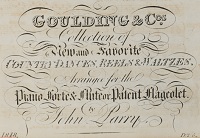
|
This collection was arranged by John Parry and is dated to 1818.
The contents are: Le Gascon Volage, Teasing Made Easy, The Waterloo Dance, The Young May Moon (as now Danced), Miss Debbett's Waltz, Don Giovanni, The Black Dwarf, Pantaloon (a Quadrille), L'Ete (a Quadrille), Claremont House, La Poule (a Quadrille), The Marble Horse, The Bard's Legacy, The Fatal Island, La Daphne (a Quadrille), La Matilda, The Young Hussar, La Lisette, The Caroline, The Libertine.
Full Title: Goulding & Cos Collection of New and Favorite Country Dances, Reels & Waltzes, 1818. Price 2s6d. |
Twenty Four Country Dances for the Year 1819 |
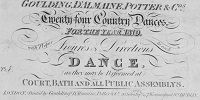
|
The contents are: The Exquisite, Rob Roy Mc Gregor, Up All Night, The Green Man, The Blue Waltz, Orlando's Return, The Dandy's Whim, The Logerian Fancy (Tune 100 Guineas), The Trifle, The Lancers, The Fudge, The Indians, Madge Wildfire, The Amulet (G.B.S.), Tickaty Robin, Marian's Dream, Close at Your Elbow, The Grecian (G.B.S.), The Widow Trueby, The Law of the Land, The Maria (G.B.S.), My Conscience, The Favorite (G.B.S.), The Circle Waltz.
Full Title: Goulding, D'Almaine, Potter & Cos Twenty-four Country Dances For the Year 1819, with Proper Figures & Directions to each Dance (as they may be performed at) Court, Bath, and all Public Assemblys. Price 1s. |
New & Favorite Country Dances, Reels & Waltzes, 1819 |

|
This collection was arranged by John Parry and is dated to 1819.
The contents are: The Caleidoscope, Up All Night, Marmotte (a Quadrille), The Logerian Fancy (Tune 100 Guineas), The Dandy's Whim, Rob Roy McGregor, The Maria, The Lydia Waltz, My Conscience, Lovell Heath (a Quadrille), The Homberg Waltz, The Circle Waltz, The Wizard's Waltz, The Amulet, The Plain Fact, Royal Nuptials, The North Pole, The Green Man, Puss in Boots, The Cambrian Waltz.
Full Title: Goulding & Cos Collection of New and Favorite Country Dances, Reels & Waltzes, 1819. Price 2s6d. |
Twenty Four Country Dances for the Year 1820 |

|
The contents include: The Last Word, The Northdown Waltz, Columbia (By permission of the Author Mr Parry), The Dandy's Hobby, Philomel, The Corydon, La Vestale (By Permission of Mr Parry), Hookey Walker.
Full Title: Goulding, D'Almaine, Potter & Cos Twenty-four Country Dances For the Year 1820, with Proper Figures & Directions to each Dance (as they may be performed at) Court, Bath, and all Public Assemblys. Price 1s. |
Twenty Four Country Dances for the Year 1821 |
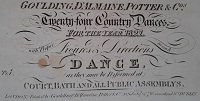
|
The contents are: The Caroline (P), The Vampire (P), The Eccentric (I. George), The Diamond Ring (P), Portman Lodge (I. George), Cinderella, Woman's Will (P), La Petit Chaperon Rouge, Brandenburgh House (I. George), Ivanhoe (P), Hullin's Hornpipe (I. George), Soldier Laddie, Henri Quatre (Bishop), The Little Devil (P), Sir Piercie Shufton (E.A.W.), The True Briton (P), Dan Stubble (P), The Sophia (P), Rosette (P), Take A Hint (P), I Canna Munna Tell Ye (P), The Coronation, The Promissory Note (P), The Seventeenth of August (P).
A comment withing records All the dances marked with a P are Copyright as well as those with the Composers names affix'd to them. .
Full Title: Goulding, D'Almaine, Potter & Cos Twenty-four Country Dances For the Year 1821, with Proper Figures & Directions to each Dance (as they may be performed at) Court, Bath, and all Public Assemblys. Price 1s. |
Twenty Four Country Dances for the Year 1822 |

|
The contents are: The King's Welcome to Ireland, Two Wives, Rise and Fall, The Carnival of Venice, Au Clair de la Lune, The Coronation of George The 4th, The Royal Tour, Billy Twist, Tast Mi Tasi, Captain Bounce, Tancredi, Sandy McCloed, Kenmure's On and Awa, White Snowdon, Charlie is my Darling, The Royal Squadron, Winny Wilkins, Love's Dream, Patrick O'Niel, The Discovery, The Moon Beams, The Bonassus, The Diving Bell, The Persian Beauty.
Full Title: Goulding, D'Almaine, Potter & Cos Twenty-four Country Dances For the Year 1822, with Proper Figures & Directions to each Dance (as they may be performed at) Court, Bath, and all Public Assemblys. Price 1s. |
Twenty Four Country Dances for the Year 1823 |
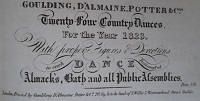
|
The contents are: King George's Welcome to Scotland, The Parthenon, Le Petit Tambour, The Law of Java, An They're A' Noddin, Gil Blas, Carl, an the King Come, The Denmark Waltz, Mount and Go, Peter Fin, The Campbells are Coming, The New Gretna Green, Little Cupid Am I, Smile Again My Bonnie Lassie, The Pirate, The Hibernian Waltz, Coming Thro' The Rye, Juan Bellinck, or Le Diable Superbe, The Heptaplasiesoptron, Ramo Samee, The Royal Rudder, Albion, The Paris Quadrille, Philip Quarl.
Full Title: Goulding, D'Almaine, Potter & Cos Twenty-four Country Dances For the Year 1823, with Proper Figures & Directions to each Dance Performed at Almack's, Bath, and all Public Assemblies. Price 1/0. |
Twenty Four Country Dances for the Year 1824 |
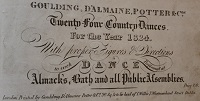
|
The contents are: Aurora, Sweethearts and Wives, Amour, Mr Goose, The Cabriolet, Presumption, La Donna Del Lago, The Russian Mountains, Zitti Zitti, Cauld Kail of Aberdeen, The Dashing White Sargeant (Bishop), Quentin Durward, The Spanish War Song, Love is a Mischievous Boy (Bishop), The Little Foot Page (Bishop), County Guy, The Roving Minstrels (P), The Cosmorama, Polly Hopkins, Mina (P), Dusty Bob, The Pilot, The Foresters (Bishop), Oh! Weel May The Boatie Row (Bishop).
Full Title: Goulding, D'Almaine, Potter & Cos Twenty-four Country Dances For the Year 1824, with Proper Figures & Directions to each Dance Performed at Almack's, Bath, and all Public Assemblies. Price 1/0. |
New & Favorite Country Dances, Reels & Waltzes, 1824 |
|
This collection was arranged by John Parry and is dated to 1824.
The contents (courtesy of WorldCat) are: Aurora, The Cabriolet, Zitti Zitti, The Russian Mountains, The Dashing White Sargeant, The Roving Minstrels, Polly Hopkins, The Foresters, Sweethearts and Wives, C'est l'Amour, Oh! This love!, Mister Goose, Mina, La Chasse d'Amour, Paul et Virginia, My Highland Home (Bishop), The Great Unknown (Parry), Dusty Bob, County Guy, The Cosmorama, Prince Hohenlohe!!! or the Miracle.
|
Twenty Four Country Dances for the Year 1826 |

|
The contents are: The Huntsmen's Chorus, Agnes, Jock of Hazledean, Le Solitaire, O' Twine A Wreath, Giovinetto Cavalier, Der Freishutz Waltz, Casper's Song, Lucy Dear, Faustus, William Tell, Captain Clapperton, Il Crociato, Algiers Waltz, The Enterprise, The Fly-Flappers, Anatomie Vivante, Old Ebony, Uncle Gabriel, Quite Correct, The Crusaders, Walladmoor, The Infant Lyra,
La Neige.
Full Title: Goulding & D'Almaine's Twenty-four Country Dances For the Year 1826, with Proper Figures & Directions to each Dance Performed at Almack's, Bath, and all Public Assemblies. Price 1/0. |
Twenty Four Country Dances for the Year 1827 |

|
The contents are: Buy a Broom, The Death Fetch, I am Twining, Draw the Sword Scotland, Blame Me not My Gentle Laddie, The Oracle, I'll Watch for Thee, Poor Relations, Command Me Not to Leave You, The Sun is O'er the Mountain, Are You Angry Mother, Lying made Easy, O! Merry Row the Bonnie Bark, Aladdin, Hither, Love Hither, My Ain Fire Side, Blue Bonnets are over the Border, St. David's Day, Medea, Crosswood, The Maria, I Loe na'a Laddie but Ane, Oberon, In Happier Hours.
Full Title: Goulding & D'Almaine's Twenty-four Country Dances For the Year 1827, with Proper Figures & Directions to each Dance Performed at Almack's, Bath, and all Public Assemblies. Price 1/0. |
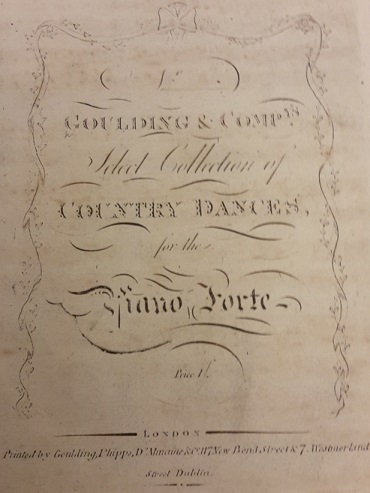
Figure 5. A c.1804 cover for No 1 Goulding & Compy's Select Collection of Country Dances for the Piano Forte (a work that I suspect might date to 1802 or 1803).
Irregularly issued Goulding & Co. Country Dance Collections
In addition to their numerous annual Country Dance publications, Goulding & Co also sold at least 48 Numbers of a series of publications loosely referred to as their Select Collection of Country Dances. Each such publication consisted of four sides of paper with five to eight dance tunes contained within. There were two lines of music, a tenor and a bass, for each such tune; in most cases there were no suggested dance figures. Anyone who bought these collections did so for the music alone. The tunes themselves were of a high quality and, in most cases, were genuinely popular tunes widely known from other publications and understood to have been in general use for social dancing (this is in stark contrast to most of the tunes from the dated collections). The other major property of these collections is that they were numbered but undated; we can reasonably assume that #2 was produced after #1, but determining a likely publication date for the individual numbers remains a bit of a challenge.
The precise title of these works did change over time; what began as a Select Collection of Country Dances (see Figure 5) would later become a Select Collection of Elegant Country Dances and later still a Select Collection of Country Dances, Waltzes, &c . Similar publications were being issued by other music publishers in London, often using similar publication names. I tend to refer to such works as Numbers , this is a convention that I have found used in surviving legal writs from the 1810s; the industry itself seems to have informally referred to such works as Numbers . In addition to the title changes, the covers of the works also evolved over time; five major designs can be found in use at different dates, with several minor variations within a single design. The design changes are sometimes linked to their address changing, or the company name changing. Some of the later Numbers in the collection do identify the composers of the tunes (often only by their initials); most do not do so, but in a few cases we can take a guess as to who the composer is likely to have been.
Dating the Numbers is a bit of a challenge. There are significant clues we can use, there are also some pitfalls to avoid. The first thing to note is that the cover itself can be misleading. The earlier works in the collection remained on sale many years after they were first produced, the cover would simply be replaced on later copies with whatever the current cover was. This means that an older work may be found with a newer cover. This isn't mere speculation, in several cases I've studied multiple copies of the same work under two different covers. For example, I've studied two copies of #2, one with a cover that likely dated to around 1804 and one with a cover that dated to around 1812; the content was the same in both cases. A similar observation can be made over the age of the paper; a watermark will indicate the date at which the paper was manufactured but not the date at which the printing plates (and therefore the content of the work) were made. It is also possible for a newer work to have an older cover, perhaps because Goulding had yet to invest the effort to modernise the design; for example, the copy of #20 that I've studied had a cover that was created for use with #17 (and therefore still displayed their old business address on the front). It transpires that relying on the cover itself is a poor tool for dating the content of these works.
We'll discuss the likely publication dates for these works in a moment, first it's worth noting that the frequency of publication did change significantly over time. The earlier part of the range probably saw only one or two publications per year; whereas around 13 Numbers were issued between 1811 and 1813, frequency then slowed down again thereafer. It's likely that the series was in production between about 1802 and 1823, I've been able to study copies of most of the Numbers with the exception of the tail end of the sequence.
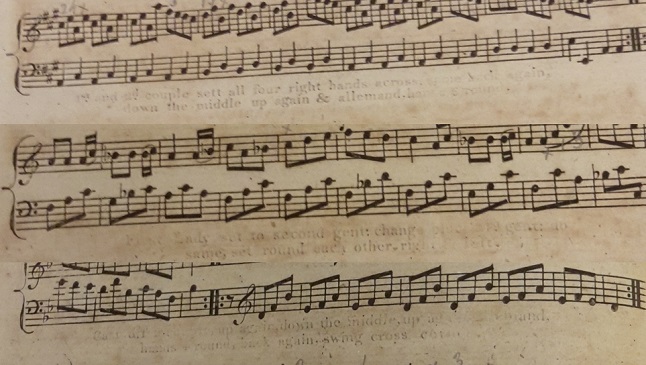
Figure 6. Examples of the ghostly suggested dance figures found in the copy of the First Number that I've studied.
There are a few external dating clues that can help pin down the original publication dates. There are references to specific volumes within Newspaper advertisements for example; we can confirm that #7 dates to no later than September 1805, #17 to no later than February 1810 and #35 to no later than July 1815. It's reasonable to assume that the most recent Number is being referred to in those advertisements. Once we have a few secure dates we can attempt to gauge when the other Numbers are likely to have been published. The next clue comes from the names of the tunes, several allude to historical events: #8 includes a tune that alludes to the 1805 Battle of Trafalgar, #13 to events of the Peninsular War, #17 to the O.P. riots of 1809, #19 to the 1811 Battle of Barrosa, #22 to the 1811 French retreat from Portugal, #25 to Sweden changing sides in 1812, #32 to the Dutch overthrowing the French in late 1813, #35 to the 1814 capture of Napoleon, #36 to the 1815 Battle of Waterloo, #44 to the Coronation of 1821... and so forth. Several further references can be found to stage productions: #6 refers to a production from 1804, #7 to one from 1805, #9, #10 and #11 to productions from 1807, #25 to a production from 1812, #39 and #40 to productions of 1817, #41 to productions of 1818, #48 to productions of 1823, etc.. Combining all of these clues results in a reasonably likely set of dates for most of the collection. In most cases we can triangulate the likely publication dates down to approximately a year or so.
The main uncertainty in the dating involves the first two Numbers in the collection. The earliest copies of these works that I've studied have covers that date to no earlier than 1804, and yet I suspect they may have been created before then. First of all, I've seen a copy of #6 with a cover indicating that the Goulding address was at 45 Pall Mall, that was probably issued in early 1804 so the preceding titles in the series were probably issued before then. The contents of these early works offer few clues however, the tunes could have been selected and printed at almost any date spanning a decade or more of time. One intriguing clue is that #2 contains a tune name Peace , I find this to be indicative of the brief period of peacetime that followed the March 1802 Treaty of Amiens; sadly that peace ended in May of 1803. Britain would remain in constant European warfare for many years thereafter. It seems unlikely to me that a tune named Peace would be published after hostilities had already been resumed, so I suspect #2 could date to that period spanning later 1802 and early 1803. The first Number in the collection is also curious; the copy that I've studied (see Figure 5) is unusual as the cover was printed around 1804 yet it contains faded dance figures that are indicative of an earlier version having previously existed (see Figure 6). That is, there is clear evidence that suggested dance figures had previously existed for this work, attempts appear to have been made for them to not be present in the copy that I've studied (perhaps the dance figures were deliberately left uninked during production). This leads me to suspect that despite studying an early copy, earlier still editions had been produced at an earlier date; these earlier versions (perhaps dating to 1802 or 1803) probably contained the suggested dance figures. Presumably Goulding & Co. made a decision not to include these figures in their collections after that initial number, perhaps in recognition that dancers at the more elite of social dance assemblies were encouraged to pick figures of their own choice when dancing. I've not found these ghostly figures in any of the other Numbers.
There are two further anomalies to mention before we turn to the publications themselves. We've just mentioned that the very first Number at some point in the past contained suggested dance figures and that the other Numbers did not, yet there is an exception: the Coronation Dance from the 1821 #44 was also printed with figures. The specific dance could be enjoyed either as a Country Dance or as a Quadrille using the supplied arrangement. The other anomaly involves the c.1812-13 #28 in the collection, it is interesting for reproducing content that is clearly copied from an earlier work: it's derived from the final pages of William Napier's c.1806 Selection of Dances & Strathspeys. I don't know why this would be, the copying is not acknowledged in the publication and would be unlikely to be detected except by chance; maybe a junior employee took a shortcut and copied content from elsewhere?
We'll now consider the publications themselves, their contents and their likely initial publication dates.
| Work & Date | Image | Comments |
|---|
No 1 Select Collection of Country Dances, c.1802-1803 |

|
The contents are: Lady Mary Ramsay, Master Setwel or Not Till We Are Married, Madam Buonapartes Waltz or the Cumberland Waltz, Devil Among the Taylors, Lord Nelson's Waltze, Lady Lucy Ramsay or Fight About The Fireside, Sir David Hunter Blair's Reel, New Dash or Zoiac, Curly Locks.
I've studied what is likely to be an early printing of this work (there are traces of the suggested dance figures to be seen on the paper). This copy gives the address of the business as being 117 New Bond Street, an address that wasn't in use before 1804. I nonetheless suspect that this was first published around the years 1802 or 1803 for reasons given above.
Full Title: No 1 Goulding & Compy's Select Collection of Country Dances for the Piano Forte. Price 1s. |
No 2 Select Collection of Country Dances, c.1802-1803 |
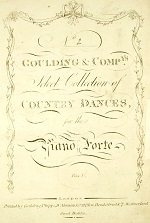
|
The contents are: The Turnpike Gate, Lady Nelson's Reel, Go to Berwick Jonny, Drops of Brandy, Lady Harriet Hopes Reel, Shaw's Waltz, Cameren has got his Wife, Jennies Baubee, Peace.
I've studied two different copies of this work, one of which was clearly a much later reprint (it lists the contents of the first 25 of these works in an index page and gives the business address to be 20 Soho Square). The earlier copy, depicted, has their address at 117 New Bond Street, an address that they used from 1804. The term Peace probably alludes to the temporary period of peace that resulted between 1802 and 1803 from the Treaty of Amiens. It would seem odd for a tune to have been named Peace after warfare had already been resumed. It therefore seems likely that this work was first published between 1802 and 1803.
Full Title: No 2 Goulding & Compy's Select Collection of Country Dances for the Piano Forte. Price 1s. |
No 3 Select Collection of Country Dances, c.1803-1804 |
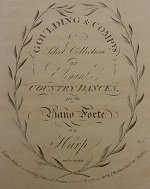
|
The contents are: Dutchess of York's Waltz, Cameronian Rant, The Newcastle Volunteers, Countess of Sutherland's Reel, Prince Adolphus' Fancy, I'll make you be fain to follow me, Neil Gow, Earl St. Vincents Hornpipe, Miss Dunn's Reel.
The copy of this work that I've studied is a later imprint with their address given as 124 New Bond Street, an address that was used from early 1808. This particular copy of the work was evidently printed later with a new cover design attached even though the contents of the work date to a few years prior. None of the tunes included hint at a particular publication date; Niel Gow died in 1807 but that doesn't seem to be important for dating purposes.
Full Title: No 3 Goulding & Compy's Select Collection of Elegant Country Dances for the Piano Forte or Harp. Price 1s. |
No 4 Select Collection of Country Dances, c.1803-1804 |
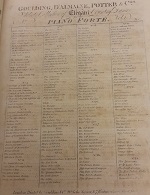
|
The contents are: Admiral Mitchel's Waltz, Lady Kinnaird's Reel, Mrs or Miss Murry, Soldier's Joy, Preston Guild, Isle of Sky, O'er the moor among the Heather,
Feudal Times, or the New Century, Duke of Gordons birth day.
The copy of this work that I've studied is a later imprint with their address given as 20 Soho Square, an address that was used from early 1810. This particular cover indexed the contents of the first 25 Numbers in the collection, a clear clue that it is a later printing. None of the tunes included hint at a particular initial publication date.
Full Title: No 4 Goulding, D'Almaine, Potter & Co's Select Collection of Elegant Country Dances for the Piano Forte. Price 1s. |
No 5 Select Collection of Country Dances, c.1804 |
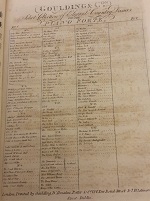
|
The contents are: Lady Charlotte Benticks Fancy, Laura and Lenza, General McBean's Reel, British Liberty, The Scotch Ghost, Lady Caroline Lee's Waltz.
The copy of this work that I've studied is a later imprint with their address given as 124 New Bond Street, an address that was used from early 1808. This particular cover indexed the contents of the first 17 Numbers in the collection, a clear clue that it is a later printing. Laura et Lenza was the name of a ballet produced from 1801, Scotch Ghost was the name of a ballet that was especially popular between 1801 and 1805; neither strongly hint at a specific publication date.
Full Title: No 5 Goulding & Co's Select Collection of Elegant Country Dances for the Piano Forte. Price 1s. |
No 6 Select Collection of Country Dances, c.1804 |
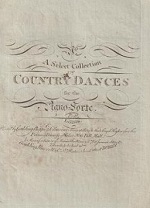
|
The contents are: The Loyal Briton's, Miss Eliza St Georges Fancy, Valentine's Day, The Silver Star, The Caledonian Beauty, Guilty or Not Guilty.
The copy of this work that I've studied is an early imprint with their address given as 45 Pall Mall, an address that was used between 1799 and 1804. The Silver Star probably alludes to a harlequinade produced from April 1803, whereas Guilty of Not Guilty probably references a comedic play produced from May 1804. It seems likely that this work was initially created in 1804.
Full Title: No 6 Select Collection of Country Dances for the Piano Forte. Price 1s. |
No 7 Select Collection of Country Dances, c.1805 |
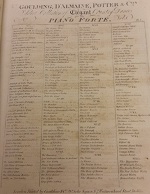
|
The contents are: The Honey Moon, Murphy Delany, Off She Goes, What You Like, Mrs Garden of Troop, or Barbara & Allen, The Meteor.
The copy of this work that I've studied is a later imprint with their address given as 20 Soho Square, an address that was used from early 1810. This particular cover indexed the contents of the first 25 Numbers in the collection, a clear clue that it is a later printing. A reference to this publication, and its contents, can be found in the British Press newspaper for the 2nd of September 1805, it is therefore probable that it was first published around that date in 1805. The name Barbara & Allen alludes to a ballet which had been produced since 1801, The Honey Moon was a production from February 1805.
Full Title: No 7 Goulding, D'Almaine, Potter & Co's Select Collection of Elegant Country Dances for the Piano Forte. Price 1s. |
No 8 Select Collection of Country Dances, c.1806 |
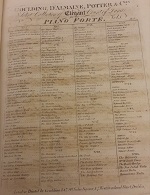
|
The contents are: Paddy O'Carril, Cape Trafalgar, Hanoverian Waltz, Miss Johnson of Houghton Hall, The Cambrian Lyrist or Morgan in London, Lady Maria Parker's Reel, Caro Dolce, The Dutchess of Bedford's Waltz, The New Rigg'd Ship.
The copy of this work that I've studied is a later imprint with their address given as 20 Soho Square, an address that was used from early 1810. This particular cover indexed the contents of the first 25 Numbers in the collection, a clear clue that it is a later printing. The reference to Cape Trafalgar obviously alludes to the naval battle of that name from October 1805. News of the victory did not reach the London newspapers until December of 1805, therefore in all probability this work was first published in early 1806.
Full Title: No 8 Goulding, D'Almaine, Potter & Co's Select Collection of Elegant Country Dances for the Piano Forte. Price 1s. |
No 9 Select Collection of Country Dances, c.1807 |
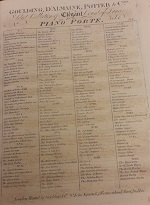
|
The contents are: The Labyrinth, The Nameless, The Tars of the Victory, I'll gang na mair to yon Town, La Ridicule a Cotillion, New Claret, The Ocean Fiend, Lord Cochrane's Waltz, Peter the Great.
The copy of this work that I've studied is a later imprint with their address given as 20 Soho Square, an address that was used from early 1810. This particular cover indexed the contents of the first 25 Numbers in the collection, a clear clue that it is a later printing. The name The Ocean Fiend probably refers to an aquatic romance produced from May 1807, Peter the Great probably refers to a drama that was also produced from May 1807.
Full Title: No 9 Goulding, D'Almaine, Potter & Co's Select Collection of Elegant Country Dances for the Piano Forte. Price 1s. |
No 10 Select Collection of Country Dances, c.1807 |
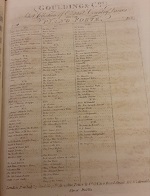
|
The contents are: Tekeli, Ap Shenkin, The Brave Cossack, The Duchess of Brunswick's Waltz, Mother Goose, Roy's Reel, The Golden Egg, Admiral Gambier's Reel, The Silver Miner's Waltz.
The copy of this work that I've studied is a later imprint with their address given as 124 New Bond Street, an address that was used from early 1808. This particular cover indexed the contents of the first 17 Numbers in the collection, a clear clue that it is a later printing. Tekeli was the name of a melodrama ballet produced from late 1806, Mother Goose was produced from around the start of 1807, the Silver Miners were a band who flourished between about 1803 and 1805. In all probability this work was first published in 1807.
Full Title: No 10 Goulding & Co's Select Collection of Elegant Country Dances for the Piano Forte. Price 1s. |
No 11 Select Collection of Country Dances, c.1807-1808 |
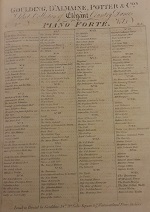
|
The contents are: Miss Spicer's Fancy, Miss Luxton's Waltz, Miss Wolffs Waltz, Paddys Wife and Children, Drops of Whiskey, Times a Tell Tale, The Young Hussar.
The copy of this work that I've studied is a later imprint with their address given as 20 Soho Square, an address that was used from early 1810. This particular cover indexed the contents of the first 25 Numbers in the collection, a clear clue that it is a later printing. The name Young Hussar probably refers to an operatic piece produced from March 1807, Times a Tell Tale refers to a comedy that was produced from October 1807. In all probability this work was first published in either late 1807 or early 1808.
Full Title: No 11 Goulding, D'Almaine, Potter & Co's Select Collection of Elegant Country Dances for the Piano Forte. Price 1s. |
No 12 Select Collection of Country Dances, c.1808 |
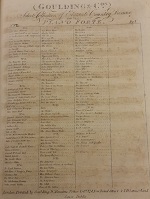
|
The contents are: The Runaway, Lord Cathcart's Welcome to Scotland, The New Waltz, Prince Dolgowicki, Miss William's Fancy, The African's Dance, Fairy Dance, The Sylphs, King of the Catties.
The copy of this work that I've studied is a later imprint with their address given as 124 New Bond Street, an address that was used from early 1808. This particular cover indexed the contents of the first 17 Numbers in the collection, a clear clue that it is a later printing. The term King of the Chatti was a title claimed by the Elector of Hesse in 1806, Prince Dolgorukov appeared in the British newspapers from around 1802 (with various spellings) as an adjutant to the Tsar of Russia. None of the tunes precisely date the collection but in all probability it dates to early 1808.
Full Title: No 12 Goulding & Co's Select Collection of Elegant Country Dances for the Piano Forte. Price 1s. |
No 13 Select Collection of Country Dances, c.1808 |
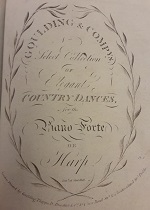
|
The contents are: The Wyddfa, Mrs Crocket, The Spanish Patriots, Shrewsbury Races, The Mayor Elect, The Forest at Delamere, Major Ogleby's Reel, Oulton Park, Alderman Sellers.
I've studied two copies of this work, one of which was clearly a later imprint than the other. The first copy (pictured) has their address as 124 New Bond Street, an address that was used from early 1808. The later copy indexed the contents of the first 25 Numbers in the collection. The earlier copy that I've studied is likely to have been in its initial form. The term Spanish Patriots came into common use in mid 1808 in reference to the Spanish partisans who sided with Britain against the occupying French forces, this work is likely to date to mid or late 1808.
Full Title: No 13 Goulding & Compy's Select Collection of Elegant Country Dances for the Piano Forte or Harp. Price 1s. |
No 14 Select Collection of Country Dances, c.1809 |

|
The contents are: Morgiana, The Spanish Patriots, The Prime of Life, The Fairy Prince, Leiber Augustine, Capper Fey, Miss Ray, or Shaddie, Miss Parkinsons Strathspey.
I've studied two copies of this work, one of which was clearly a later imprint than the other. The first copy (pictured) has their address as 124 New Bond Street, an address that was used from early 1808. The later copy indexed the contents of the first 25 Numbers in the collection. The earlier copy that I've studied is likely to have been in its initial form. The tunes included don't hint at a specific initial publication date but the collection is likely to date to around 1809.
Full Title: No 14 Goulding & Compy's Select Collection of Elegant Country Dances for the Piano Forte or Harp. Price 1s. |
No 15 Select Collection of Country Dances, c.1809 |
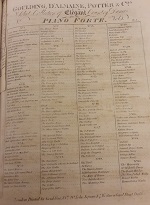
|
The contents are: The Harriettes, The Stralsund Waltz, Momfrina, Montreal, Madam Catalani's Waltz, The Russian Waltz, The Silver Miners (A Pandean Dance), The Calabria, Grimaldi's Favorite.
The copy of this work that I've studied is a later imprint with their address given as 20 Soho Square, an address that was used from early 1810. This particular cover indexed the contents of the first 25 Numbers in the collection, a clear clue that it is a later printing. The tunes in the collection don't particularly imply a specific publication date but the work is likely to have first been published in 1809.
Full Title: No 15 Goulding, D'Almaine, Potter & Co's Select Collection of Elegant Country Dances for the Piano Forte. Price 1s. |
No 16 Select Collection of Country Dances, c.1809 |
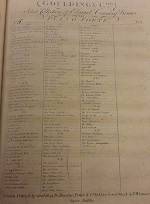
|
The contents are: Flora McDonald, The New Spanish Patriots, Basque Roads, The Exile, Princess Dolgorucki, The Gallop, Lord Cathcart.
The copy of this work that I've studied is a later imprint with their address given as 124 New Bond Street, an address that was used from early 1808. This particular cover indexed the contents of the first 17 Numbers in the collection, a clear clue that it is a later printing. None of the tunes precisely date the collection but in all probability it dates to around 1809.
Full Title: No 16 Goulding & Co's Select Collection of Elegant Country Dances for the Piano Forte. Price 1s. |
No 17 Select Collection of Country Dances, c.1810 |
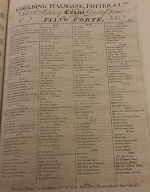
|
The contents are: The O P Rattle, The Triumph, The Reconciliation, The O.P. Dance, The Free Knights, Morgiana in Ireland, The Persian Ambassador, Crop The Croppies, The Valiant.
Goulding & Co's Irish subsidiary published an advertisement in the Saunders's News-Letter newspaper for the 22nd of February 1810 which referenced this publication along with its entire contents. Curiously the price for the work in Dublin was a penny more than the cost in London. It was evidently published either in early 1810 or late 1809. The copy of this work that I've studied is a later imprint with their address given as 20 Soho Square. This particular cover indexed the contents of the first 25 Numbers in the collection, a clear clue that it is a later printing. The term O.P. refers to the Old Price riots of late 1809.
Full Title: No 17 Goulding, D'Almaine, Potter & Co's Select Collection of Elegant Country Dances for the Piano Forte. Price 1s. |
No 18 Select Collection of Country Dances, c.1810 |
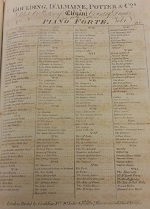
|
The contents are: The Tank, La Terza, The Persian Dance, Miss Gayton's Hornpipe, The Bay of Rosas, The Jubilee Dance, Morning Star.
The copy of this work that I've studied is a later imprint with their address given as 20 Soho Square. This particular cover indexed the contents of the first 25 Numbers in the collection, a clear clue that it is a later printing. The tunes in the collection don't particularly imply a specific publication date but the work is likely to have first been published in 1810.
Full Title: No 18 Goulding, D'Almaine, Potter & Co's Select Collection of Elegant Country Dances for the Piano Forte. Price 1s. |
No 19 Select Collection of Country Dances, 1811 |
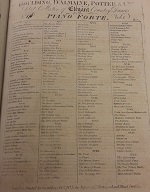
|
The contents are: Genl Grahams Victory, Lord Ramsey's Reel, The Merry Lads of Ayr, The Redicule (A New Reel), Neil Gows Wife, Miss Williams Fancy, Greigs Pipes, Juliana.
The copy of this work that I've studied is a later imprint, this particular cover indexed the contents of the first 25 Numbers in the collection, a clear clue that it is a later printing. The reference to General Graham alludes to the 1811 Battle of Barrosa. This work was almost certainly published in or shortly after the month March 1811, there would be little reason to reference this event at any later date.
Full Title: No 19 Goulding, D'Almaine, Potter & Co's Select Collection of Elegant Country Dances for the Piano Forte. Price 1s. |
No 20 Select Collection of Country Dances, c.1811 |
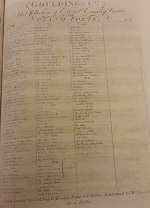
|
The contents are: Kinloch of Kinloch, Prusian Waltz, Conjuring Music, A Trip to the Cottage, The Wolds of Sussex, Miss West's Waltz, Lady Anna Maria Stanhope's Fancy.
The copy of this work that I've studied has the potential to be a first edition, the cover indexed the contents of only the first 17 Numbers in the collection. It gave their address as 124 New Bond Street despite the business having moved to Soho Square by the date this was likely to have been issued. None of the tunes in this collection hint at a clear publication date but it's likely to date to 1811.
Full Title: No 20 Goulding & Co's Select Collection of Elegant Country Dances for the Piano Forte. Price 1s. |
No 21 Select Collection of Country Dances, c.1811 |
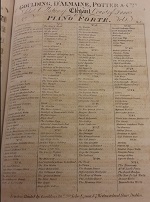
|
The contents are: Peterborough House, Lady Wellingtons Fancy, Morgiana In France, The Rovers of Weimer, Soho House, Miss Waters Fancy, M.P. Hornpipe, Managers Last Kick.
The copy of this work that I've studied is a later imprint, this particular cover indexed the contents of the first 25 Numbers in the collection, a clear clue that it is a later printing. None of the tunes in this collection hint at a clear publication date but it's likely to date to 1811.
Full Title: No 21 Goulding, D'Almaine, Potter & Co's Select Collection of Elegant Country Dances for the Piano Forte. Price 1s. |
No 22 Select Collection of Country Dances, 1811 |
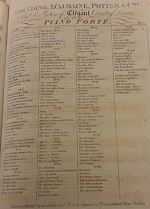
|
The contents are: Larkins, Lord Wellington, Lady Elphinston's Favorite, The Barbara, Culver Lodge, Robin Adair, Massena's Retreat, Guaracha Dance.
The copy of this work that I've studied is likely to be from the initial printing. The cover indexed the contents of the first 21 Numbers in the collection so was likely of a new design at this date, it lists their address as 20 Soho Square. The name Massena's Retreat alludes to the French withdrawal from Portugal in April 1811 following a failure to take the Lines of Torres Vedras.
Full Title: No 22 Goulding, D'Almaine, Potter & Co's Select Collection of Elegant Country Dances for the Piano Forte. Price 1s. |
No 23 Select Collection of Country Dances, c.1811-1812 |
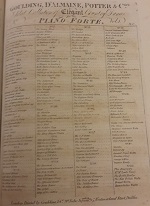
|
The contents are: Voulez Vous Dansez Mademoiselle, The Muses, Madame Catalani's Waltz, The Recovery, Sicilan Dance, Morgiana In Spain, Miss Palmer's Reel.
The copy of this work that I've studied is a later imprint, this particular cover indexed the contents of the first 25 Numbers in the collection, a clear clue that it is a later printing. None of the tunes in this collection hint at a clear publication date but it's likely to date to late 1811 or early 1812.
Full Title: No 23 Goulding, D'Almaine, Potter & Co's Select Collection of Elegant Country Dances for the Piano Forte. Price 1s. |
No 24 Select Collection of Country Dances, c.1811-1812 |
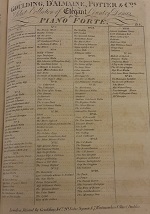
|
The contents are: Marietta (L.W.), Wilford Jig (J.B.), General Hope's Waltz (J.B.), Almeria's Fancy (J.B.), Orange and Blue (F.S.), Supper's Ready (L.W.).
The copy of this work that I've studied is likely to be from the initial printing, the cover indexed the contents of the first 21 Numbers in the collection. None of the tunes hint at a specific publication date, the work is nonetheless likely to have been published in late 1811 or early 1812.
Full Title: No 24 Goulding, D'Almaine, Potter & Co's Select Collection of Elegant Country Dances for the Piano Forte. Price 1s. |
No 25 Select Collection of Country Dances, 1812 |
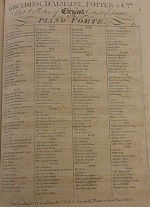
|
The contents are: The Discovery (Composed by Mr. Hughes), Mrs. McLoed's Fancy, Petersburgh Waltz, The Devils Bridge, The New Polish Waltz, Dorset Waltz, Bernadotte's Waltz.
The copy of this work that I've studied is likely to be from the initial printing. The cover indexed the contents of the first 25 Numbers, it lists their address as 20 Soho Square. The name Devil's Bridge refers to an operatic romance that was produced at London's Lyceum Theatre from May 1812; the name Bernadotte's Waltz may allude to the peace concluded between Britain and Sweden in July 1812. The work almost certainly dates to 1812.
Full Title: No 25 Goulding, D'Almaine, Potter & Co's Select Collection of Elegant Country Dances for the Piano Forte. Price 1s. |
No 26 Select Collection of Country Dances, 1812 |
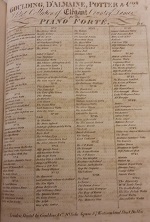
|
The contents are: Morgiana in Russia (Composed by Mr Hughes), Regency Waltz, Boney in Russia, Bath Waltz, Count Belino's Waltz, Rosalvina's Waltz.
The copy of this work that I've studied is likely to be from the initial printing. The cover indexed the contents of the first 25 Numbers, it lists their address as 20 Soho Square. The name Boney in Russia clearly refers to Napoleon's invasion of Russia in June 1812, the name Count Belino refers to a character from the 1812 Devil's Bridge. The work probably dates to 1812.
Full Title: No 26 Goulding, D'Almaine, Potter & Co's Select Collection of Elegant Country Dances for the Piano Forte. Price 1s. |
No 27 Select Collection of Country Dances, c.1812 |
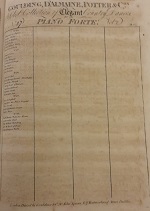
|
The contents are: Henry's Fancy, Lady Bruce, The College Hornpipe, St Julian's Cottage, The Comet, The Woodbine, The Tyrolese.
The copy of this work that I've studied is a later imprint, this particular cover indexed the contents of the 26th through 30th Numbers in the collection, a clear clue that it is a later printing. The name The Comet relates to the great comet of 1811 and 1812, this work probably dates to 1812.
Full Title: No 27 Goulding, D'Almaine, Potter & Co's Select Collection of Elegant Country Dances for the Piano Forte. Vol 2. Price 1s. |
No 28 Select Collection of Country Dances, c.1812-13 |
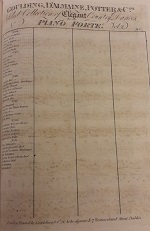
|
The contents are: Carrick's Reel, Lady Montgomeries Strathspey, The big Boat of Ensware, Speed the Plough, Cupid in Ireland, Brichin Castle, Weymouth Fete.
The copy of this work that I've studied is a later imprint, this particular cover indexed the contents of the 26th through 30th Numbers in the collection, a clear clue that it is a later printing. The contents of this work are reprinted from the final pages of William Napier's c.1806 Selection of Dances & Strathspeys, the process by which the content came to be reused is unclear. This work is likely to have been published in late 1812 or early 1813.
Full Title: No 28 Goulding, D'Almaine, Potter & Co's Select Collection of Elegant Country Dances for the Piano Forte. Vol 2. Price 1s. |
No 29 Select Collection of Country Dances, c.1812-13 |
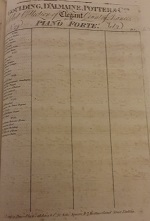
|
The contents are: Lucy Campbell, Long Live the Prince Regent, Pray Goody, Lady Barbara Cooper, Lady Mary.
The copy of this work that I've studied is a later imprint, this particular cover indexed the contents of the 26th through 30th Numbers in the collection, a clear clue that it is a later printing. The name Pray Goody refers to a song that was popular between 1812 and 1813, the work probably dates to a similar period.
Full Title: No 29 Goulding, D'Almaine, Potter & Co's Select Collection of Elegant Country Dances for the Piano Forte. Vol 2. Price 1s. |
No 30 Select Collection of Country Dances, c.1813 |
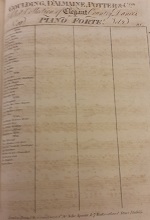
|
The contents are: Lord Moira's Welcome Home, Gernovick's Reel, The Millers Wedding, Mrs Mcleod of Rosa, Copenhagen Waltz.
The copy of this work that I've studied is likely to be from the initial printing. The cover indexed the contents of the 26th through 30th Numbers. The name Copenhagen Waltz may allude to the peace treaty between Denmark and Britain that was signed in January 1814 but had been predicted since the start of 1813 (and in the wake of Danish defeat at the 1812 Battle of Lyngor).
Full Title: No 30 Goulding, D'Almaine, Potter & Co's Select Collection of Elegant Country Dances for the Piano Forte. Vol 2. Price 1s. |
No 31 Select Collection of Country Dances, c.1813 |
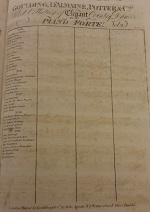
|
The contents are: Prince Kutusoff, Lord Macdonald's Reel, Lady Admiral Gordon's Strathspey, Miss Wederburn, Because he was a Bonny Lad, The Broken Dish, The Mizzloto, The Rein Deer.
The copy of this work that I've studied is likely to be from the initial printing. The cover indexed the contents of the 26th through 30th Numbers. The name Prince Kutusoff refers to Prince Kutuzov, the commander in chief of the Russian forces, his name regularly appeared in the British newspapers between 1812 and 1813. This work probably dates to 1813.
Full Title: No 31 Goulding, D'Almaine, Potter & Co's Select Collection of Elegant Country Dances for the Piano Forte. Vol 2. Price 1s. |
No 32 Select Collection of Country Dances, 1814 |
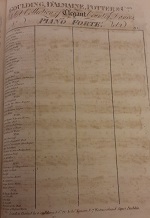
|
The contents are: The Duchess of Angouleme, The White Cockade, Teneriffe, Lady Caroline Bertie, The Calabria, Orange Boven Waltz, Maltese Dance.
The copy of this work that I've studied is a later imprint, this particular cover indexed the contents of the 26th through 33rd Numbers in the collection, a clear clue that it is a later printing. The name Orange Boven alludes to the Dutch independence from France that was achieved at the very end of 1813; the term White Cockade alludes to the Bourbon royalists in France and particularly to the fall of Bourdeaux in March of 1814, both terms were used extensively in British Newspapers in 1814. The work must surely date from 1814.
Full Title: No 32 Goulding, D'Almaine, Potter & Co's Select Collection of Elegant Country Dances for the Piano Forte. Vol 2. Price 1s. |
No 33 Select Collection of Country Dances, 1814 |
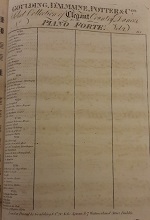
|
The contents are: The Princess Charlotte, Lord St. Orville, Calder Fair, The Sociable, Morgiana in the Park, The Queen of Prussia's Waltz, The Bequest.
The copy of this work that I've studied is likely to be from the initial printing. The cover indexed the contents of the 26th through 33rd Numbers. The name Morgiana in the Park may allude to the Jubilee Fair celebrations held in Hyde Park in August 1814. The name Queen of Prussia's Waltz likely alludes to a story from 1807 that appeared in the British newspapers in 1814; it alluded to a demand that Napoleon had made for an audience ahead of the 1807 Treaty of Tilsit, she in turn was claimed to have desired concessions for her sons. The Queen died in 1810, there was no Queen of Prussia at our c.1814 date. This work is likely to date to 1814.
Full Title: No 33 Goulding, D'Almaine, Potter & Co's Select Collection of Elegant Country Dances for the Piano Forte. Vol 2. Price 1s. |
No 34 Select Collection of Country Dances, c.1814-1815 |
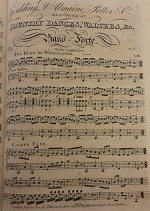
|
The contents are: The Duke of Wellington, Calder Fair, Miss Mori's Hornpipe (Danced by her at the Opera House, JDL), Lady Perth's Reel, A Trip to the Rock (Miss G.), Spanish Dance, The Scots Came O'er The Borders.
This work featured a new cover design, the old design with an index of contents was moved to the back page. The copy of this work that I've studied includes an index page that covers the contents of the 26th through 36th Numbers in the collection. The celebrated hornpipe danced by Miss Mori is references in newspapers from 1813, the other tunes in the collection don't hint at a particular publication date. It's likely to date to somewhere between 1814 and 1815.
Full Title: No 34 Goulding, D'Almaine, Potter & Co's Select Collection of Country Dances, Waltzes, &c. for the Piano Forte. Price 1s. |
No 35 Select Collection of Country Dances, 1815 |

|
The contents are: La Josephine (Composed by C.A.J.M.), The Swiss Dance (Composed by I.Parry), The Prisoner (Composed by W.R.), The Napoleon Waltz, The Chinese Bridge (Composed by I.W.H.), The Vienna Waltz.
This work featured another new cover design. The copy of this work that I've studied includes an index page that covers the contents of the 26th through 36th Numbers in the collection. Many of the tune titles allude to events of 1814 and 1815; The Prisoner hints at Napoleon being banished to Elba, so too does the Napoleon Waltz; the Chinese Bridge was a structure constructed in Hyde Park for the celebrations of 1814, the Vienna Waltz probably alludes to the 1814-1815 Congress of Vienna. The collection was advertised as New Waltzes, Dances, &c. in the Morning Post newspaper for the 8th of July 1815, it was almost certainly published shortly before then.
Full Title: No 35 Goulding, D'Almaine, Potter & Co's Select Collection of Country Dances, Waltzes, &c.&c. for the Piano Forte. Price 1s. |
No 36 Select Collection of Country Dances, 1815 |
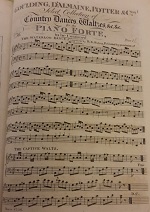
|
The contents are: The Waterloo Dance (Composed by H.R.Bishop, Published by permission of Mr Lavenu), The Captive Waltz, Trip to Brussels, La Hollandaise Waltz, La Clara, La Honorine.
The copy of this work that I've studied includes an index page that covers the contents of the 26th through 38th Numbers in the collection. Many of the tune titles allude to events of 1815, most notably to the June 1815 Battle of Waterloo and the activity around it. This work must surely date to 1815.
Full Title: No 36 Goulding, D'Almaine, Potter & Co's Select Collection of Country Dances, Waltzes, &c.&c. for the Piano Forte. Price 1s. |
No 37 Select Collection of Country Dances, 1816 |
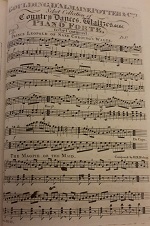
|
The contents are: Prince Leopold of Saxe Cobourg's Waltz, The Magpie or the Maid (Composed by H.R.Bishop), St. Helena,
La Belle Alliance Waltz, La Petite Nanette, The Java Dance.
The copy of this work that I've studied includes an index page that covers the contents of the 26th through 36th Numbers in the collection. Some of the tune titles allude to events of 1816. The name St Helena clearly alludes to the banishment of Napoleon in late 1815, the reference to Prince Leopold refers to the May 1816 marriage of Princess Charlotte. The reference to Java may allude to the return to Dutch control of the island of Java in 1816. The Maid and the Magpie was a stage production from 1815, La Belle Alliance is the name of the Inn at which the victorious generals met after the Battle of Waterloo. The work presumably dates to 1816.
Full Title: No 37 Goulding, D'Almaine, Potter & Co's Select Collection of Country Dances, Waltzes, &c.&c. for the Piano Forte. Price 1s. |
No 38 Select Collection of Country Dances, 1816 |
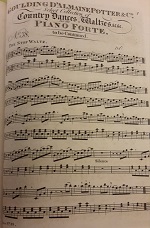
|
The contents are: The Stop Waltz, National Waltz, New May Moon or the Dandy O!, Meg Merrilies, Annette (H.R. Bishop), Bateuse.
The copy of this work that I've studied includes an index page that covers the contents of the 26th through 38th Numbers in the collection. The Stop Waltz was a popular and widely published tune in 1816, the National Waltz was a tune from a stage production named The Broken Sword from 1815. This work is likely to date to 1816.
Full Title: No 38 Goulding, D'Almaine, Potter & Co's Select Collection of Country Dances, Waltzes, &c.&c. for the Piano Forte. Price 1s. |
No 39 Select Collection of Country Dances, 1817 |
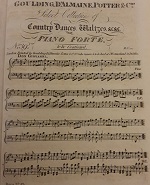
|
The contents are: Don Giovanni, Hongroise Waltz, Ghent Waltz, John Du Bart, Les Bergeres, La Czarine.
The copy of this work that I've studied includes an index page that covers the contents of the 26th through 39th Numbers in the collection. John Du Bart refers to a stage production of 1815, Don Giovanni refers to Mozart's production of 1817. This work almost certainly dates to 1817.
Full Title: No 39 Goulding, D'Almaine, Potter & Co's Select Collection of Country Dances, Waltzes, &c.&c. for the Piano Forte. Price 1s. |
No 40 Select Collection of Country Dances, 1817 |
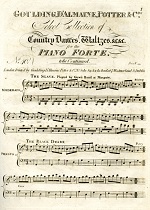
|
The contents are: The Slave (played by Gow's Band at Margate, Bishop), The Black Dwarf (Parry), Le Gascon Volage (the flying Boy), Teasing Made Easy, Claremont House (Parry), The Waterloo Dance.
The contents of this work are clearly linked to stage productions of 1817. Both Teasing made Easy and The Black Dwarf were productions of that year. The work most likely dates to 1817.
Full Title: No 40 Goulding, D'Almaine, Potter & Co's Select Collection of Country Dances, Waltzes, &c.&c. for the Piano Forte. Price 1s. |
No 41 Select Collection of Country Dances, 1818 |
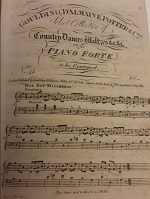
|
The contents are: Rob Roy Macgregor, Zuma, Lalla Rookh, Nicol Jarvie, Marquiss de Carrabas, or, Puss in boots, Helen Macgregor.
The contents of this work reference several productions from 1818, most notably Rob Roy MacGregor that was produced at the Theatre Royal from March of 1818. Both Helen MacGregor and Nicol Jarvie are characters from the production. Lalla Rooks was a production from 1817, Zuma from February 1818 and The Marquis of carrabas; or, Puss in Boots from March 1818. This work was almost certainly created in 1818.
Full Title: No 41 Goulding, D'Almaine, Potter & Co's Select Collection of Country Dances, Waltzes, &c.&c. for the Piano Forte. Price 1s. |
No 42 Select Collection of Country Dances, c.1819 |
|
I know of no surviving copies of this work.
The index found within Number 46 of the series gives the contents as: The Saloon, The Dandy Scramble, Jack & the Bean Stalk, The Hon Lady Neville's Waltz, Miss Tathanis Waltz, Miss Cooper's Waltz.
|
No 43 Select Collection of Country Dances, c.1820 |
|
I know of no surviving copies of this work.
The index found within Number 46 of the series gives the contents as: Emma, Anna, La Henrietta, Clarinda, La Belle Inlandoise, La Zette, The Llandaff, Maria, L'Ecossoise.
|
No 44 Select Collection of Country Dances, 1821 |

|
The contents are: The Celebrated Dance Cinderella , Le Petit Chaperon Rouge, Sir Piercie Shafton (E.A.W.), Henri Quatre (Bishop), The Coronation Dance (P).
The contents of this work reference several productions from 1820 and 1821, the reference to the Coronation (of King George IV) must date the work to 1821. The Coronation Dance is especially unusual for including dance figures, either as a Country Dance or as a Quadrille. Cindrella was a stage production from 1820, so too was Henri Quatre, Le Petit Chaperon Rouge was a production from 1821. This work will date to 1821.
Full Title: No 44 Goulding, D'Almaine, Potter & Co's Select Collection of Country Dances, Waltzes, &c.&c. for the Piano Forte. Price 1s. |
No 45 Select Collection of Country Dances, c.1821 |
|
I know of no surviving copies of this work.
The index found within Number 46 of the series gives the contents as: Au clair de la lune, The Carnival of Venice, Tancredi, Kenmure's on and awa', The Royal Tour, Tasi na Tasi.
|
No 46 Select Collection of Country Dances, 1821 |

|
The contents are: The Pirate, Walmer Castle, Geraldi Duval, Two Gentlemen of Verona, The Hanoverian Dance, Lost Life.
The name Geraldi Duval refers to a stage production from 1821, this work therefore likely dates to either 1821 or 1822. The copy I have studied includes an index to all editions issued between number 26 and number 47 of the series.
Full Title: No 46 Goulding, D'Almaine, Potter & Co's Select Collection of Country Dances, Waltzes, &c.&c. for the Piano Forte. Price 1s. |
No 47 Select Collection of Country Dances, c.1822 |
|
I know of no surviving copies of this work.
The index found within Number 46 of the series gives the contents as: The Festoon, Captain Dalgetty, Annot Lyle, The Ottoman, The Amelia Waltz.
|
No 48 Select Collection of Country Dances, 1823 |
|
The contents are (courtesy of the Wighton Collection): Maid of Milan, The Dashing White Sargeant, C'est l'Amour, The Swiss Villagers, The Cosmorama, The Prado Waltz.
I've not found a copy of this work to study. Nonetheless, the contents are clearly linked to stage productions of 1823. Both Maid of Milan and The Swiss Villagers were productions of that year. The work most likely dates to 1823.
|
Conclusion
The Goulding & Co. company (under its various names) was one of the most successful producers of printed music in early 19th century Britain. We've concentrated on investigating the social dance collections that they issued, this is only a small fragment of their much larger repertoire however. They were also celebrated as manufacturers of musical instruments. Their publications, especially the irregularly issued Numbers of Select Country Dances were some of the better such publications that the industry had to offer. These publications are especially noteworthy for remaining in production beyond the 1810s. Almost all of their competitors ceased production of similar collections in the mid to late 1810s; Button & Co. probably ceased with their 33rd Number around 1819, Skillern & Challoner probably ceased with their 22nd Number around 1815 and James Platts effectively ended his series with his 1816 48th Number. The Goulding collections offer some insight into the Country Dances of the later 1810s that is difficult to discern elsewhere.
Very few of the Goulding dance collections are currently available to view on the internet. If you have access to any and are willing to share them with the community of enthusiasts who enjoy this music, do please get in touch. And if you have anything else to share, do please Contact Us as we'd love to know more.
|


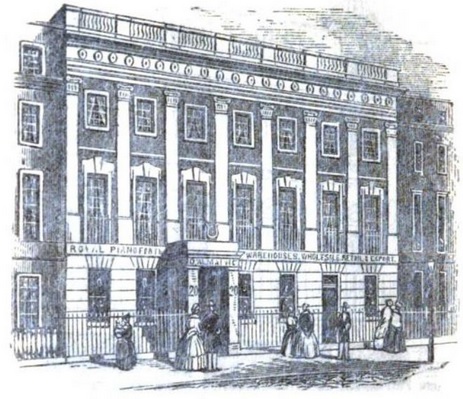 Figure 1. Goulding & Co's premises at 20 Soho Square as depicted in 1851. Image from London as it is Today, 1851.
Figure 1. Goulding & Co's premises at 20 Soho Square as depicted in 1851. Image from London as it is Today, 1851.
 Figure 2. George Goulding's trade card, c.1790, courtesy of the British Museum.
Figure 2. George Goulding's trade card, c.1790, courtesy of the British Museum.
 Figure 3. G. Goulding's Twenty four Country Dances for the Year 1800.
Figure 3. G. Goulding's Twenty four Country Dances for the Year 1800.
 Figure 4. Goulding's Select Collection of Twelve Country Dances for the Year 1807
Figure 4. Goulding's Select Collection of Twelve Country Dances for the Year 1807
 Figure 5. A c.1804 cover for No 1 Goulding & Compy's Select Collection of Country Dances for the Piano Forte (a work that I suspect might date to 1802 or 1803).
Figure 5. A c.1804 cover for No 1 Goulding & Compy's Select Collection of Country Dances for the Piano Forte (a work that I suspect might date to 1802 or 1803).
 Figure 6. Examples of the
Figure 6. Examples of the